
|
|
Kanishka was almost certainly succeeded by Huvishka, although historically there has been some confusion about this. The reason is that there are various rulers with
seemingly contradictory dates. Kanishka's known dates are 1-23 plus there is another inscription (the so-called Ara insciption, named after the place where it was found) naming
a king Kanishka son of Vajheska, dated 41. Beyond these, several more rulers are known with dates as follows:
Vajheshka, 20
Vasa Kushana, 22
Vasishka, 24-28
Huvishka, 28-62
Vasudeva, 68-98
There's a logjam in the '20s. And although there seems to be a neat transition in the year 28 from Vasishka to Huvishka, we see from the coin sequences that the coins of
Vasishka clearly belong after those of Vasudeva. Plus the coins of Vasishka themselves seem to be preceded by another series naming another Kanishka (spelled Kaneshko
on his coins), which also belong after the coins of Vasudeva. The solution, widely but not universally accepted, is that these dates pertain to two different centuries, with the
second century (Kanishka era) dates simply dropping the first (hundreds) digit. In much the same way as we write '10 to represent 2010, ancient Indian scribes were also known
to simply reduce dates to two digits by dropping the hundreds digit. This solution allows the logjam in the '20s to be eased up and to sequence the coins as well as the inscriptions
in a logical manner. (There were paleographic and art-historical reasons also why the inscriptions belonged in a different sequence than might have been suggested by the two-
digit dates alone.)
Vajheshka and Vasa Kushana are normally thought to be the same as Vasishka. Plus there appears to be another Vasudeva whose coins appear after those of Vasishka,
and who perhaps relates to another inscription naming Vasu and dated 170). Finally, there are coins naming one Shaka, who is also mentioned in an inscription of the Gupta
king Samudragupta in an inscription that must date after the year 320. The sequence of rulers we then get (with CE dates following. based on the Kanishka era starting
in 127 CE) is:
Kanishka I, 1-23 (127-150 CE)
Huvishka, 28-62 (155-189 CE)
Vasudeva I, 68-98 (195-225 CE)
Kanishka II, (c. 100-120) (227-247 CE)
Vasishka, 120-128 (247-255 CE)
Kanishka III, 141 (268 CE)
Vasudeva II, 170 (c. 275-297)
Shaka, c. 325
Huvishka's coinage is vast and varied. He issued gold dinars and quarter dinars with many different obverse types and featuring many different deites on the reverses. Göbl
identified 25 different obverse types for the gold coinage, although many of these are minor variations of one another and almost 90% of the gold dinars fall into one of the four
broad types presented in the table below. This is based on the 643 gold dinars listed by Göbl. The gold coins also feature 25 different deities on the reverse. Of these, the most
common are Ardochsho (18%), Mithra (17%), Nana (13%)< Pharro (13%) and Mao (12%). Other deities represented include: Ahura Mazda, Druvaspa, Herakles, Mahasena,
Manaobago, Oachsho, Oaninda, Oesho, Rishti, Rion, Serapis, Shahrevar, Skanda-Kumara, Bizago, and Uma (Ommo).
In presenting Huvishka's coinage, I have elected to dispense with providing details on each coin, presenting only one coin in each metal to illustrate the basic format and then
to simply provide photos of many different obverse/reverse combinations.
|
 |
Gold Dinars |
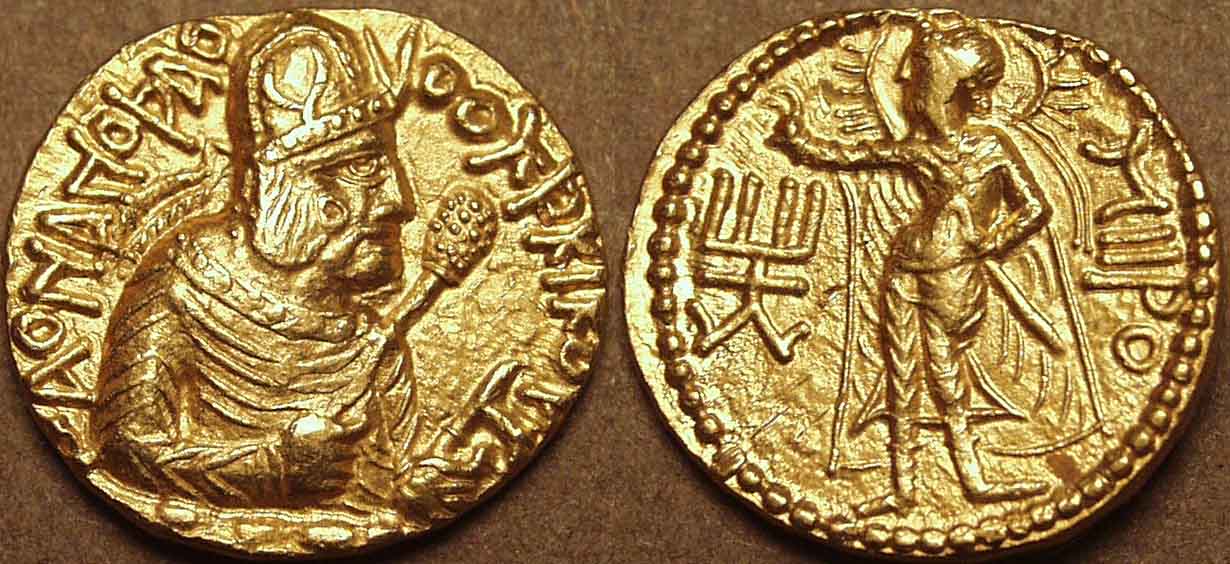
|
Gold dinar, c. 155-190 CE
Weight: 7.93 gm., Diam: 20 mm., Die axis: 1 o'clock
Crowned, diademed bust of king right, holding mace and elephant goad,
Bactrian legend around: þAONANOþAO ... OOηþKI KOþANO
Shaonanoshao Ooeshki Koshano (King of Kings Huvishka Kushan) /
Solar deity Mithra standing facing, with head turned to left, one hand on hip, the other raised in blessing,
Bactrian legend right: MIIPO, tamgha at left
Göbl 137 |
 |
Almost all of Huvishka's gold coins show the king's bust facing left; this rare type has the bust right (Göbl obverse type I).
Otherwise, the coin is quite representative of Huvishka's dinars. Their weight is almost always slightly short of 8 gm, the diameter tends to be right around 20 mm, and the die axis
is normally right around 12 o'clock. The obverse legend is also pretty standard, with only slight variations of letter form, spelling, and the break point for the legend around the king's
crown. |
\Obverse
Reverse\ |
Göbl obverse
type II |
Göbl obverse
types IX-XI |
Göbl obverse
types XII-XVI |
Göbl obverse
types XVII-XIX |
Ardochsho
Goddess of plenty |
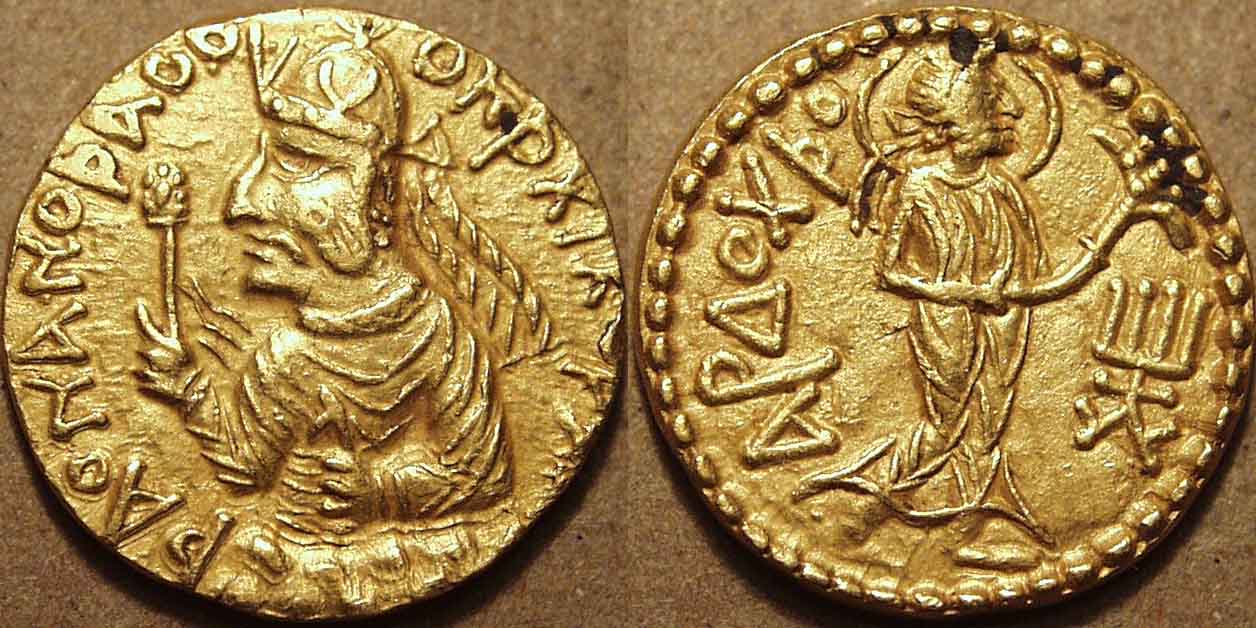 |
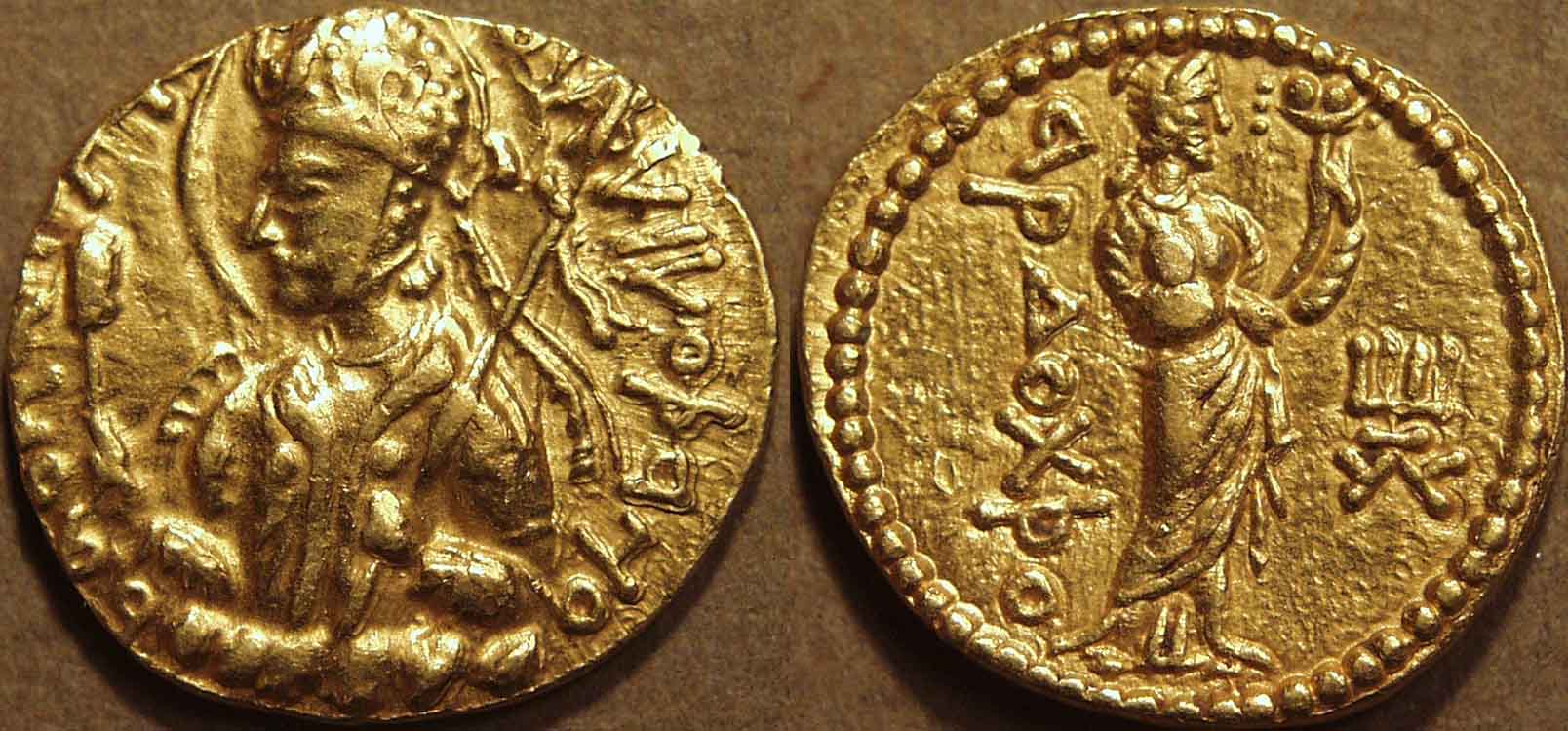 |
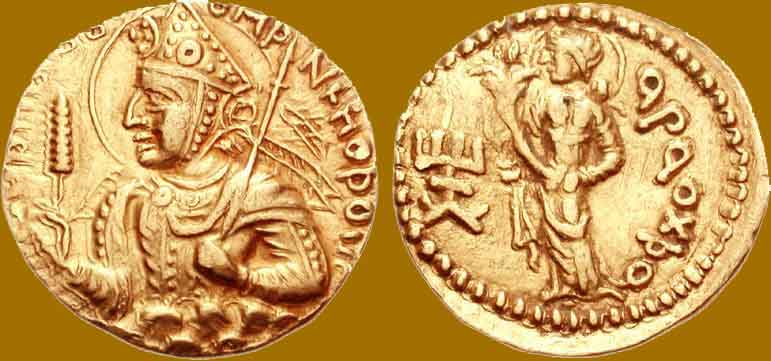 |
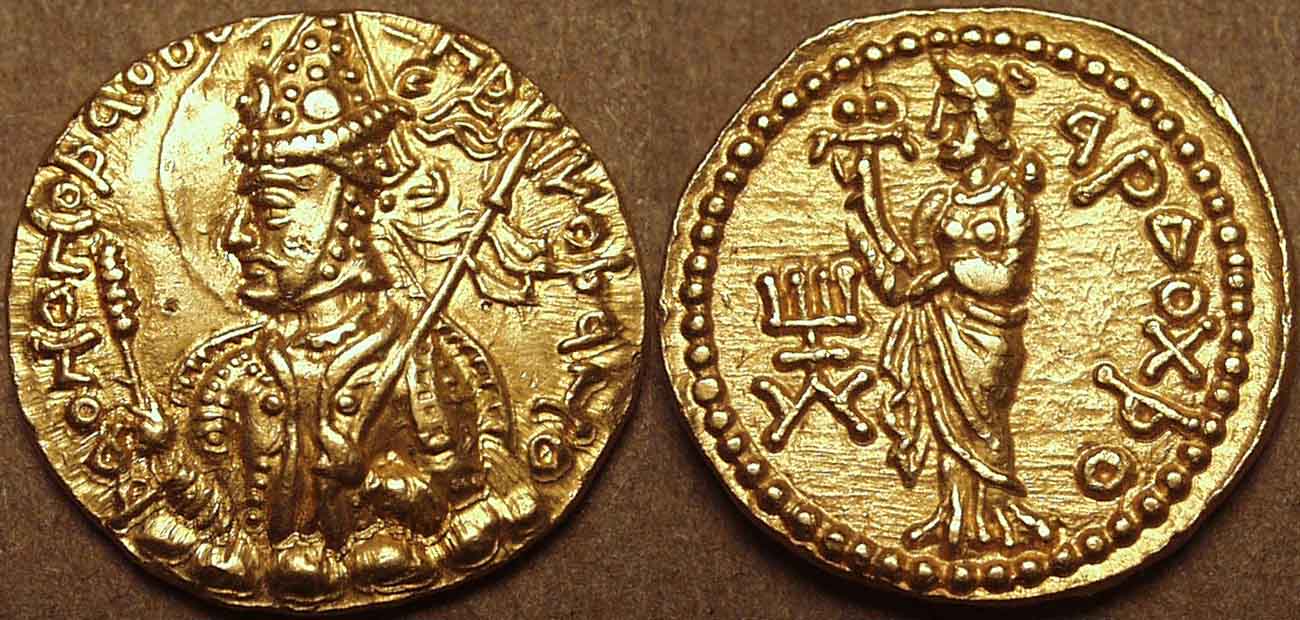 |
Athsho
God of metals & fire |
None known |
 |
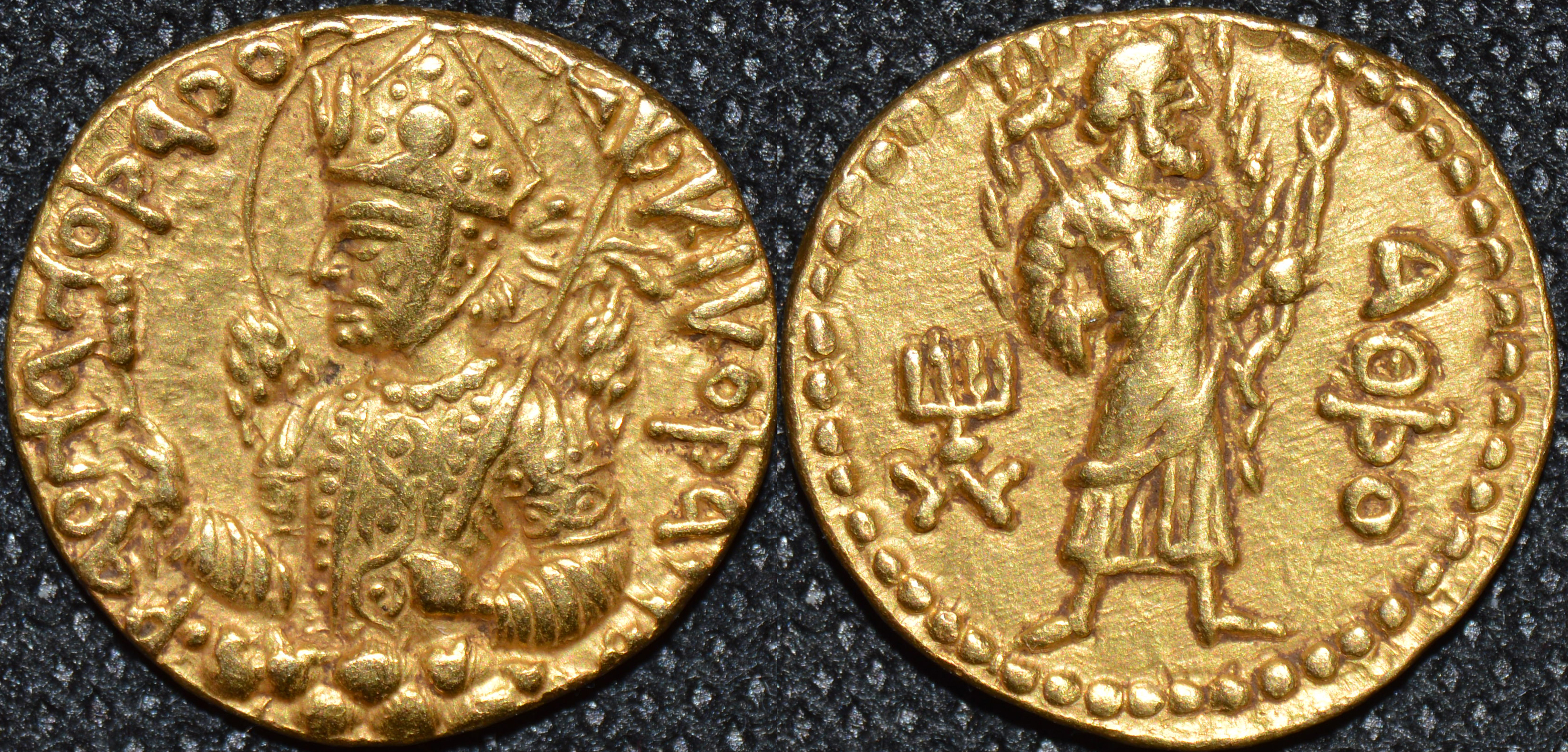 |
None known |
Mao
Lunar deity |
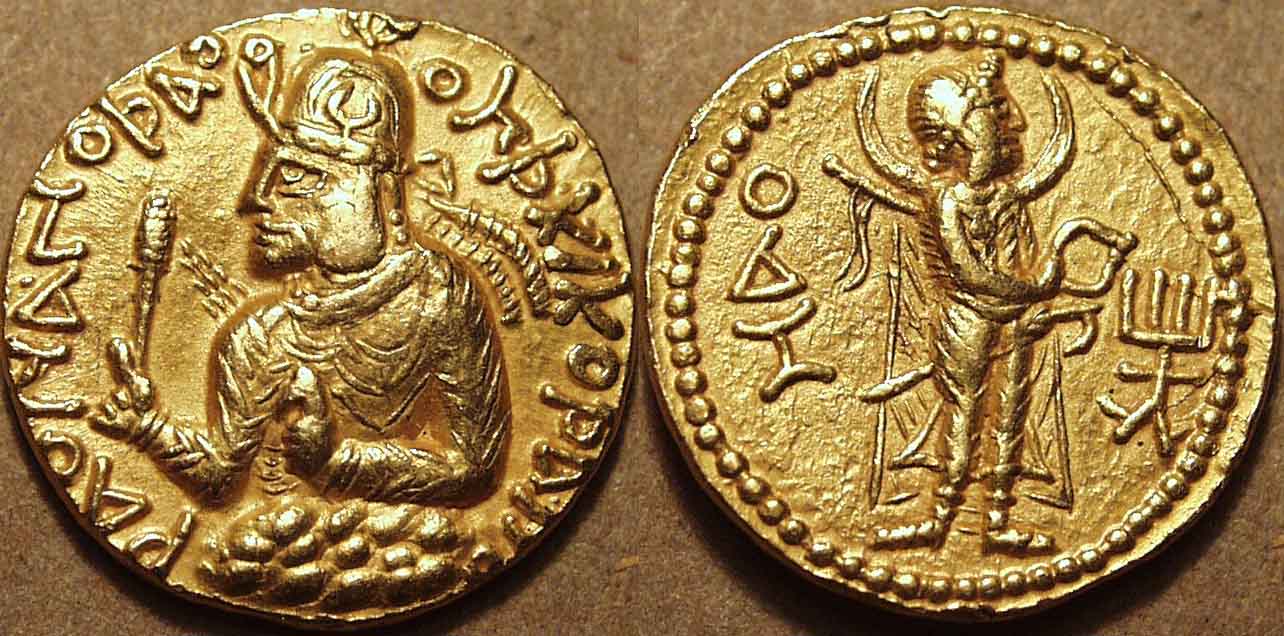 |
 |
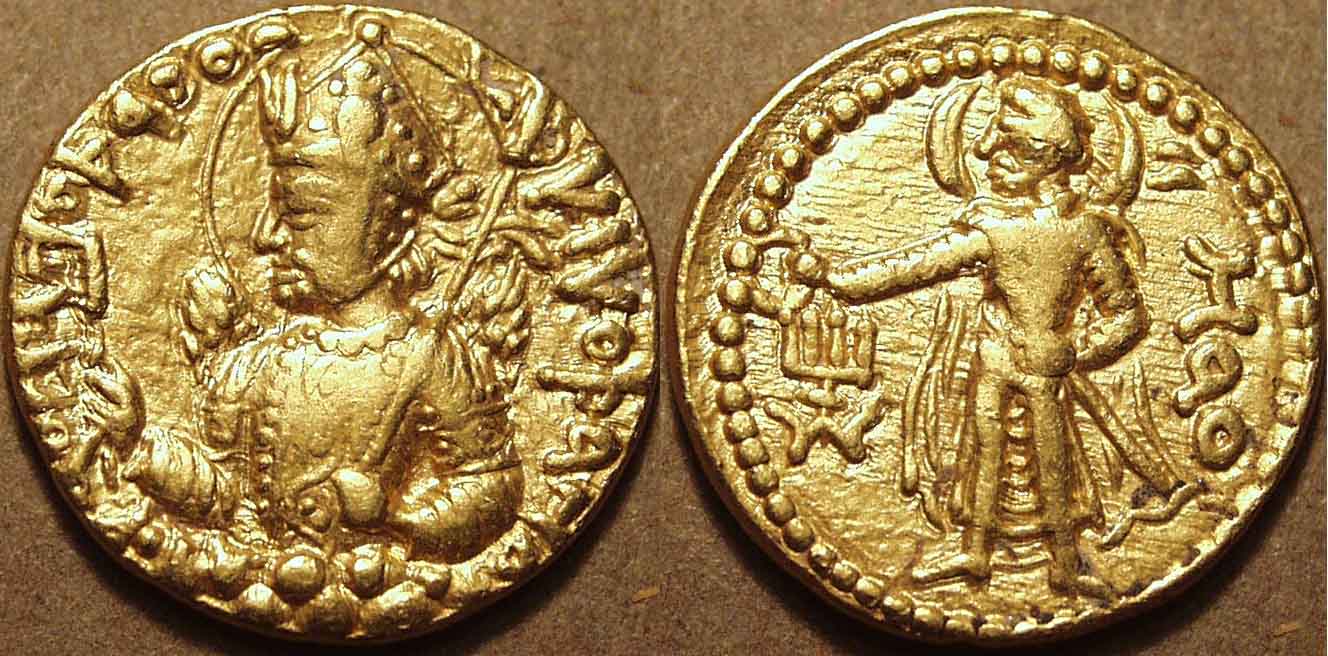 |
None known |
Mithra
Solar deity |
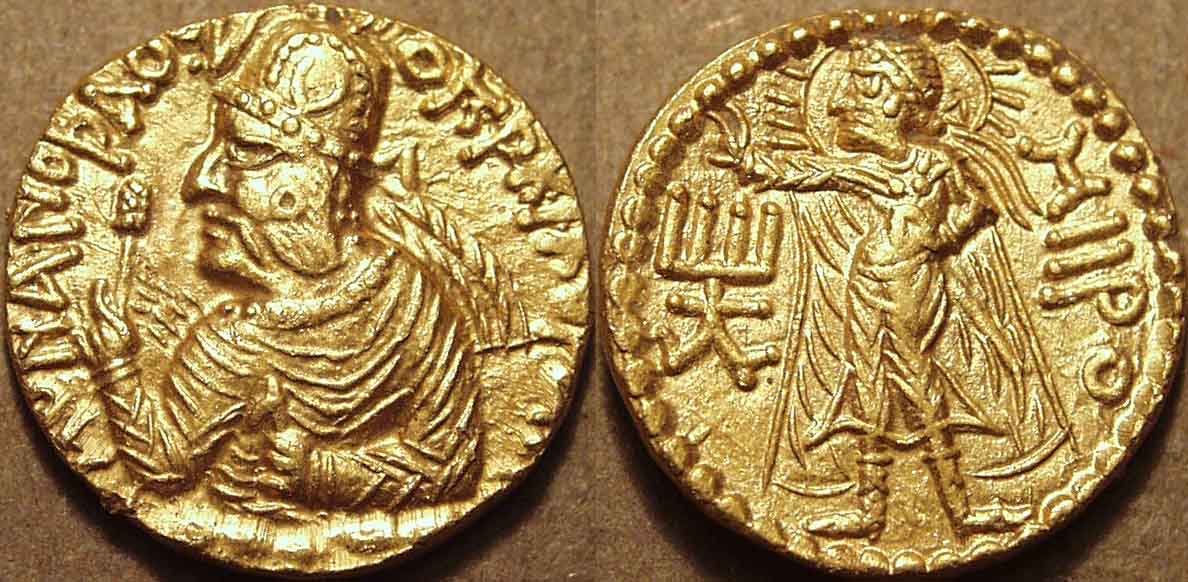 |
 |
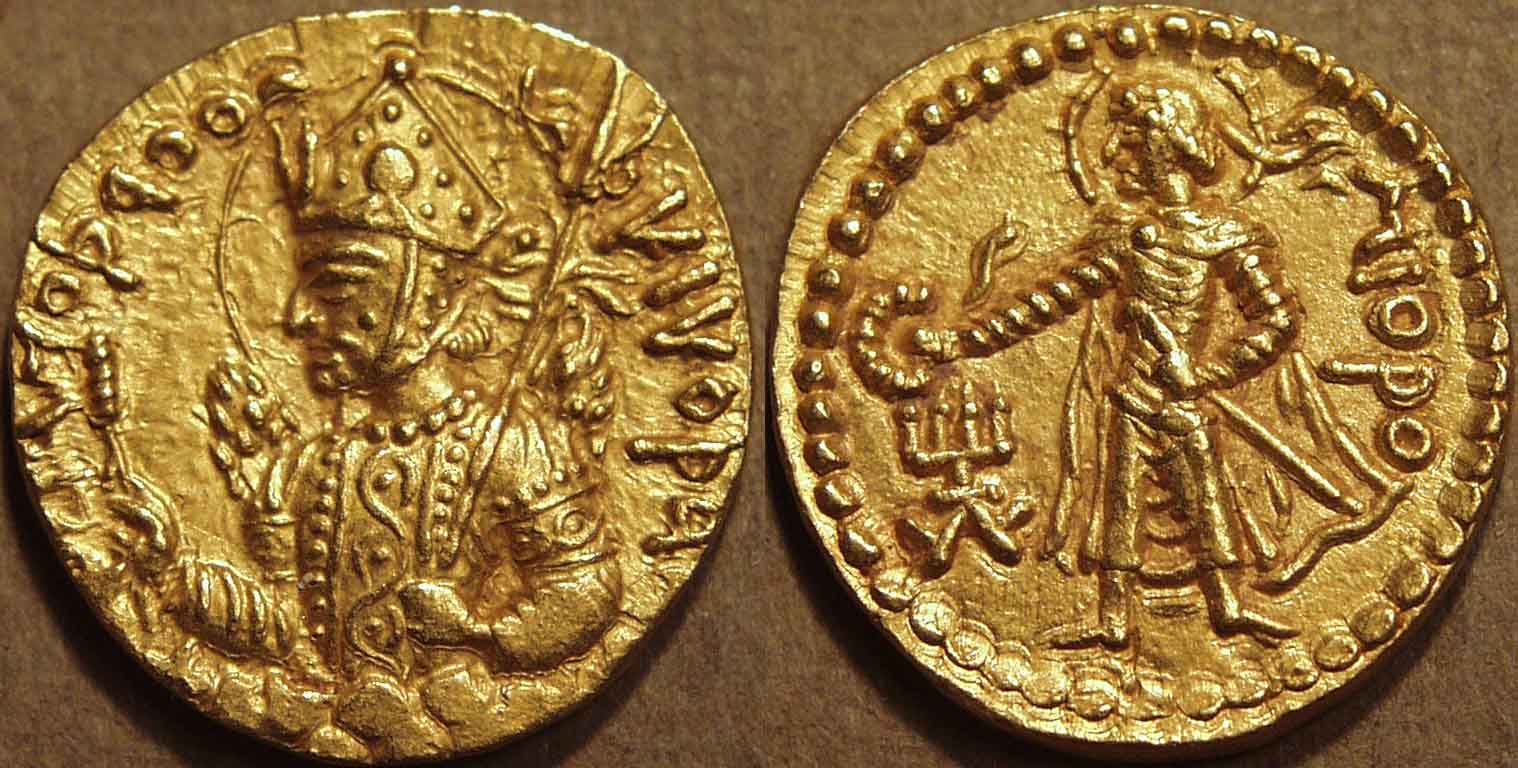 |
No photo available
Göbl 375, 380 |
Nana
Nature goddess |
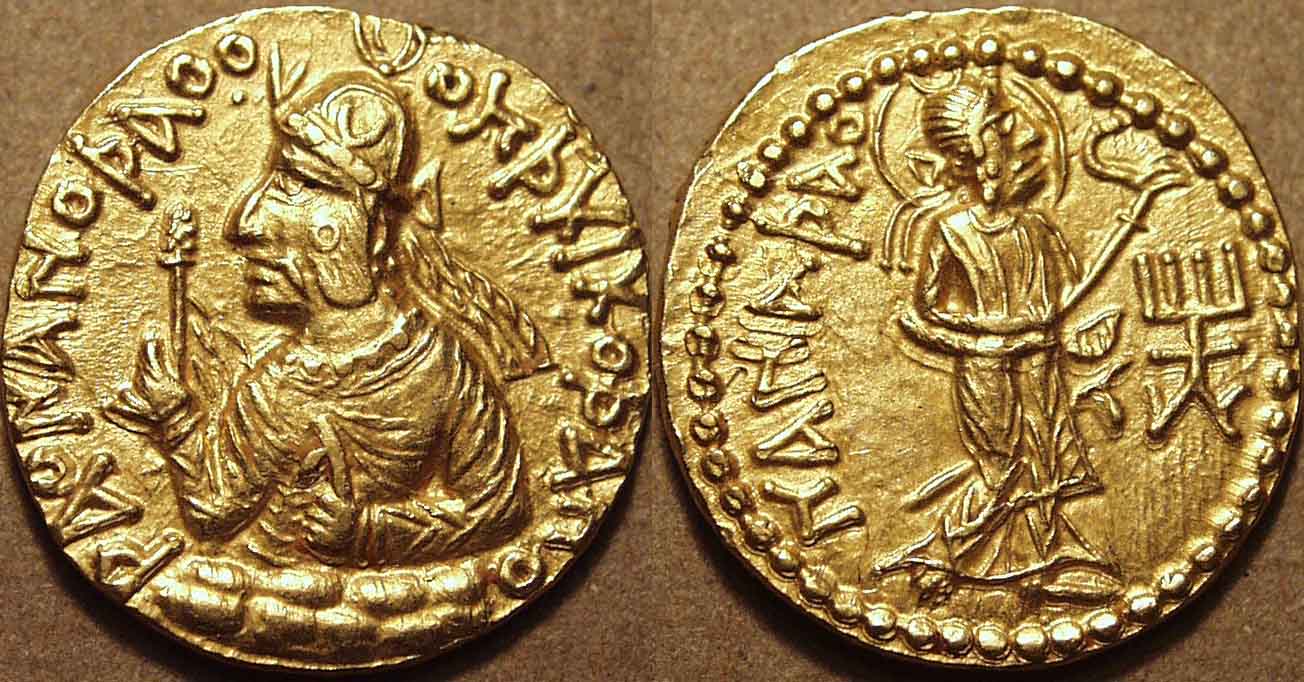 |
No photo available
Göbl 215, 232 |
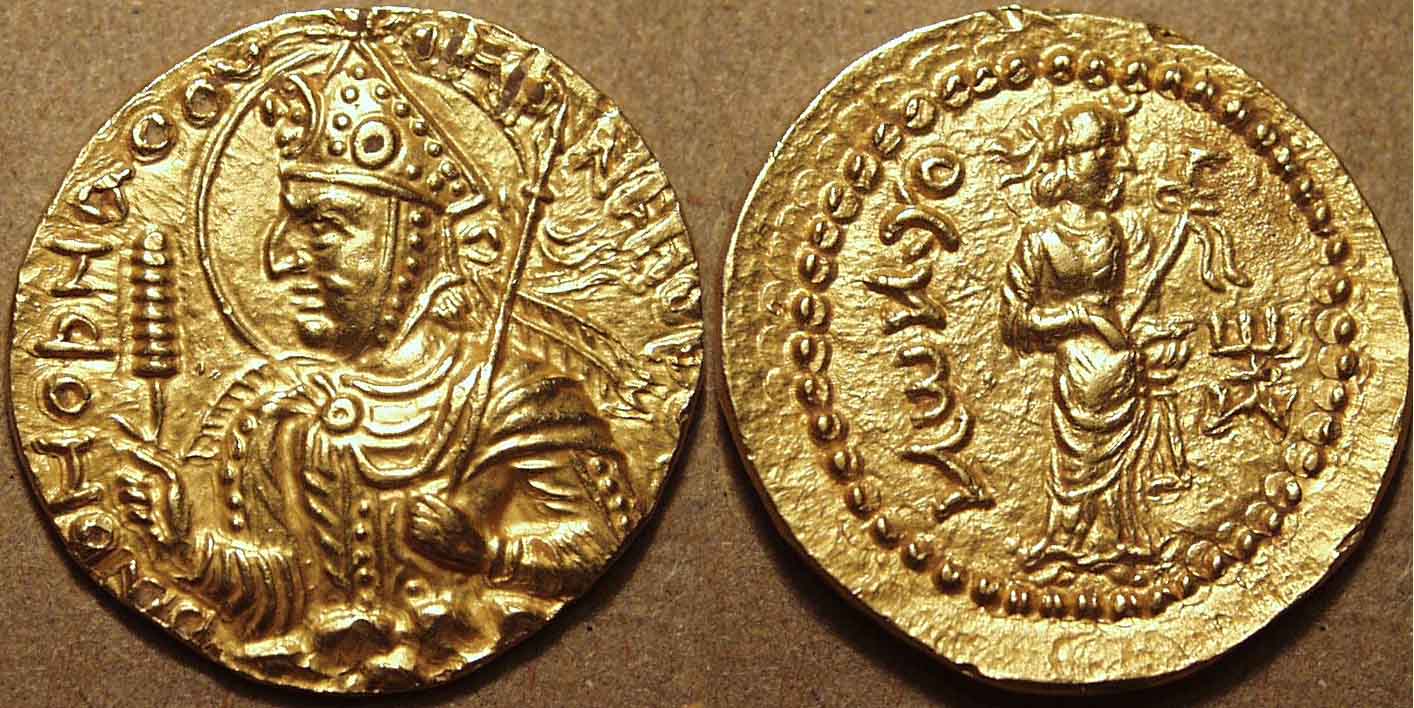 |
 |
Oesho
(Shiva?) |
 |
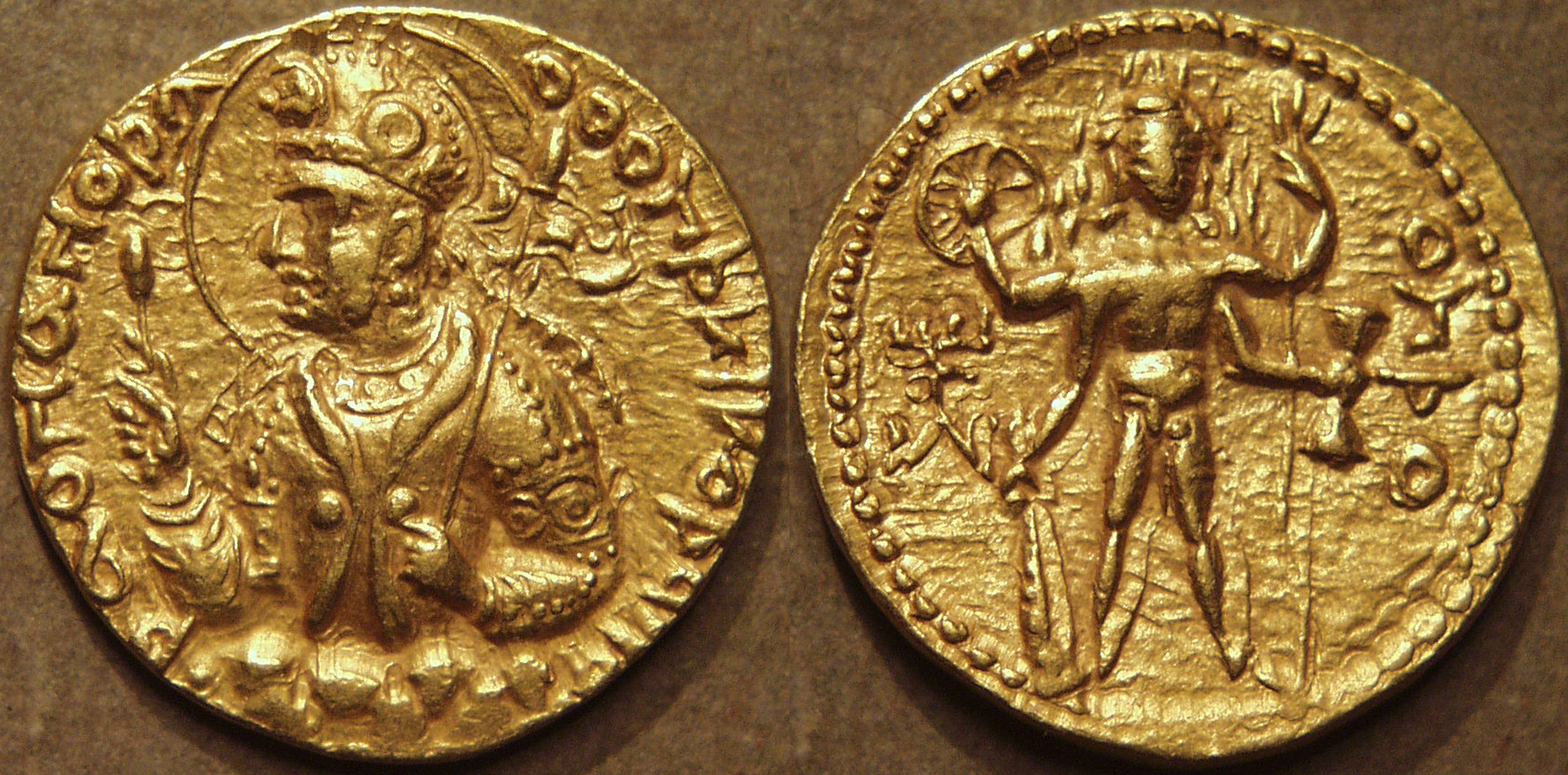 |
 |
None known |
Pharro
God who bestows royal glory |
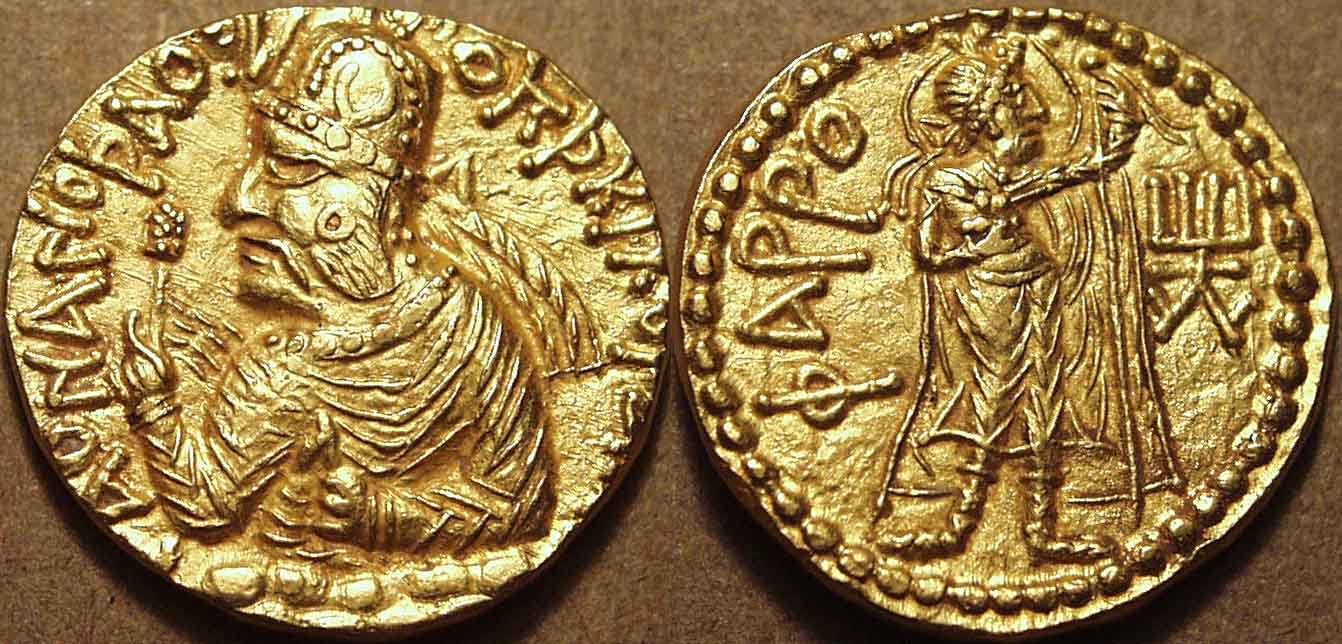 |
 |
 |
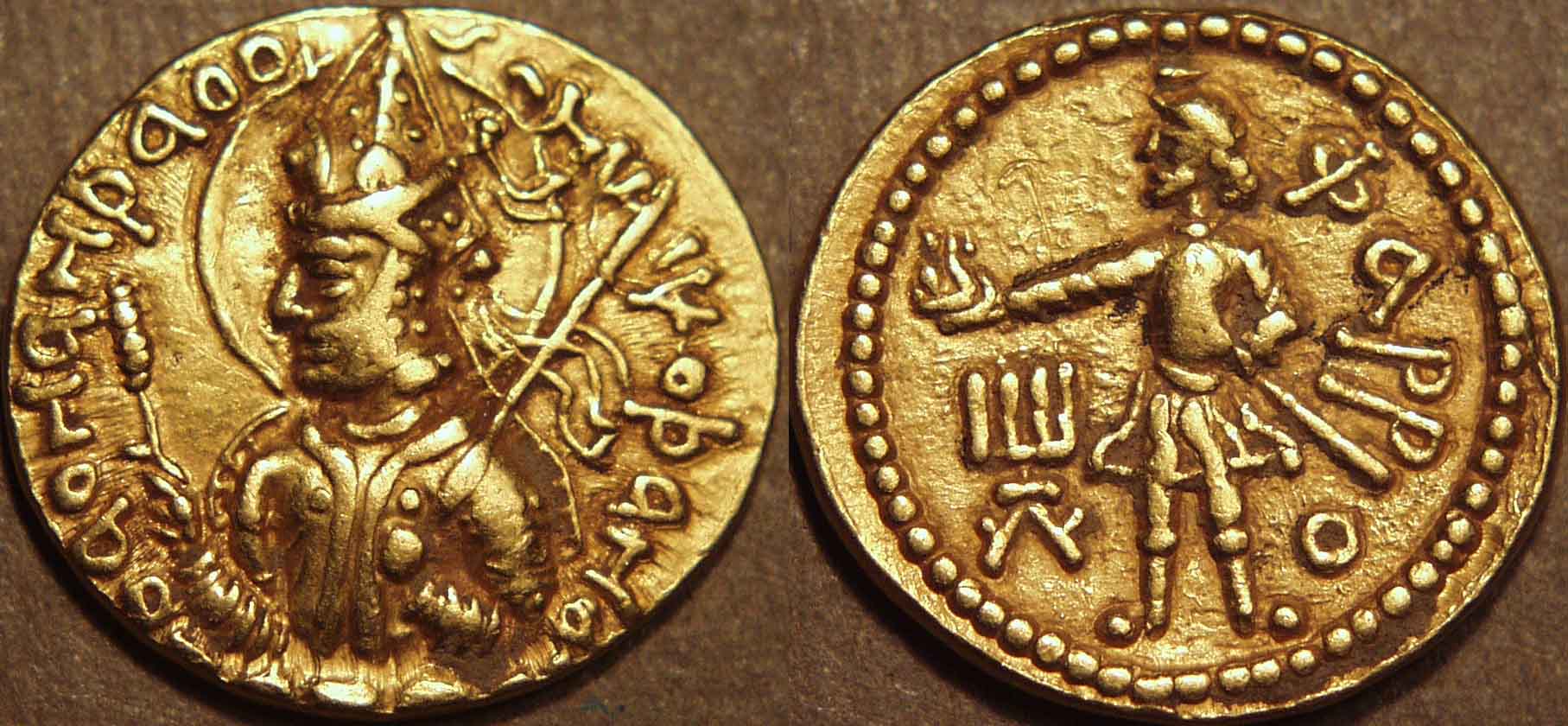 |
Shahrevar
Archetypal ruler |
None known |
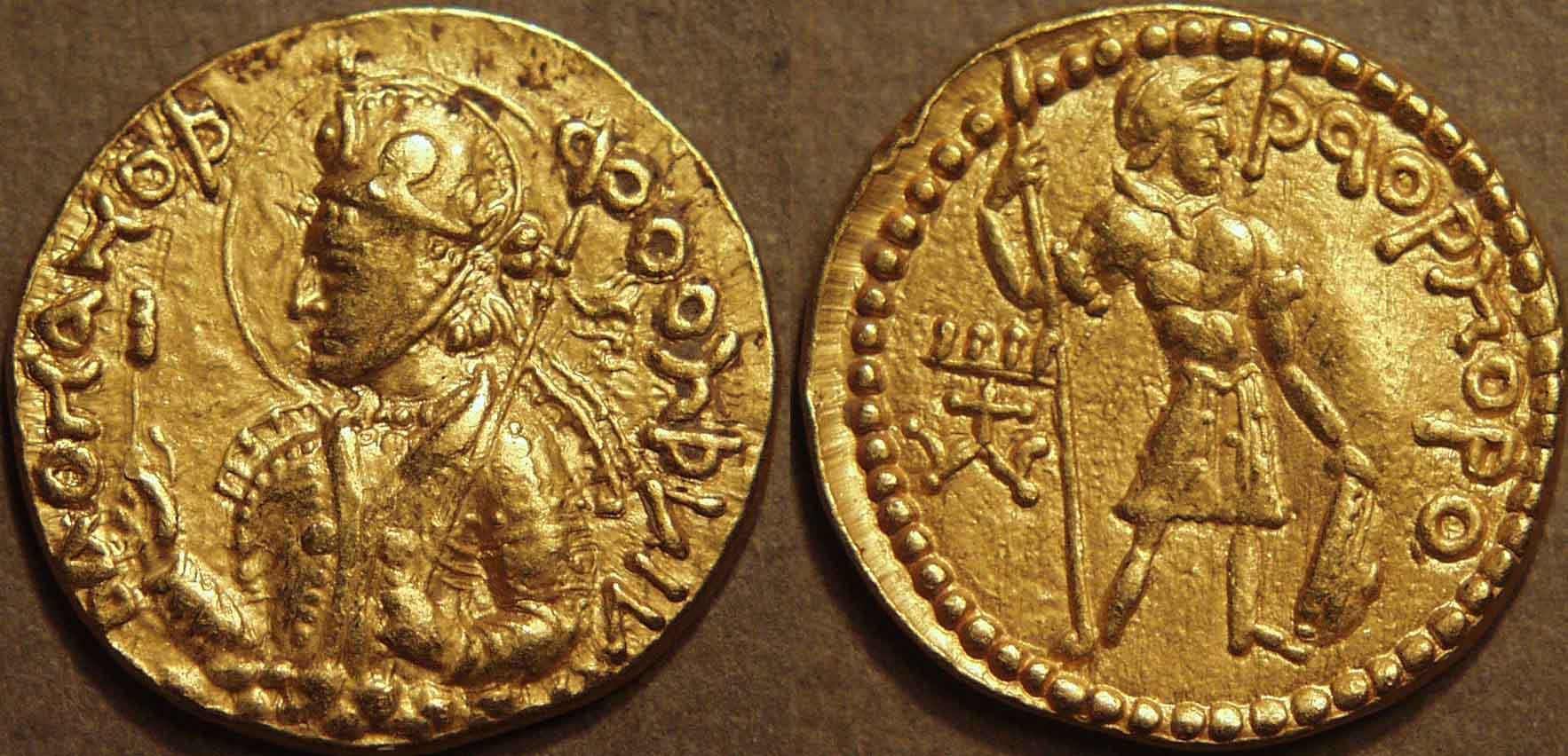 |
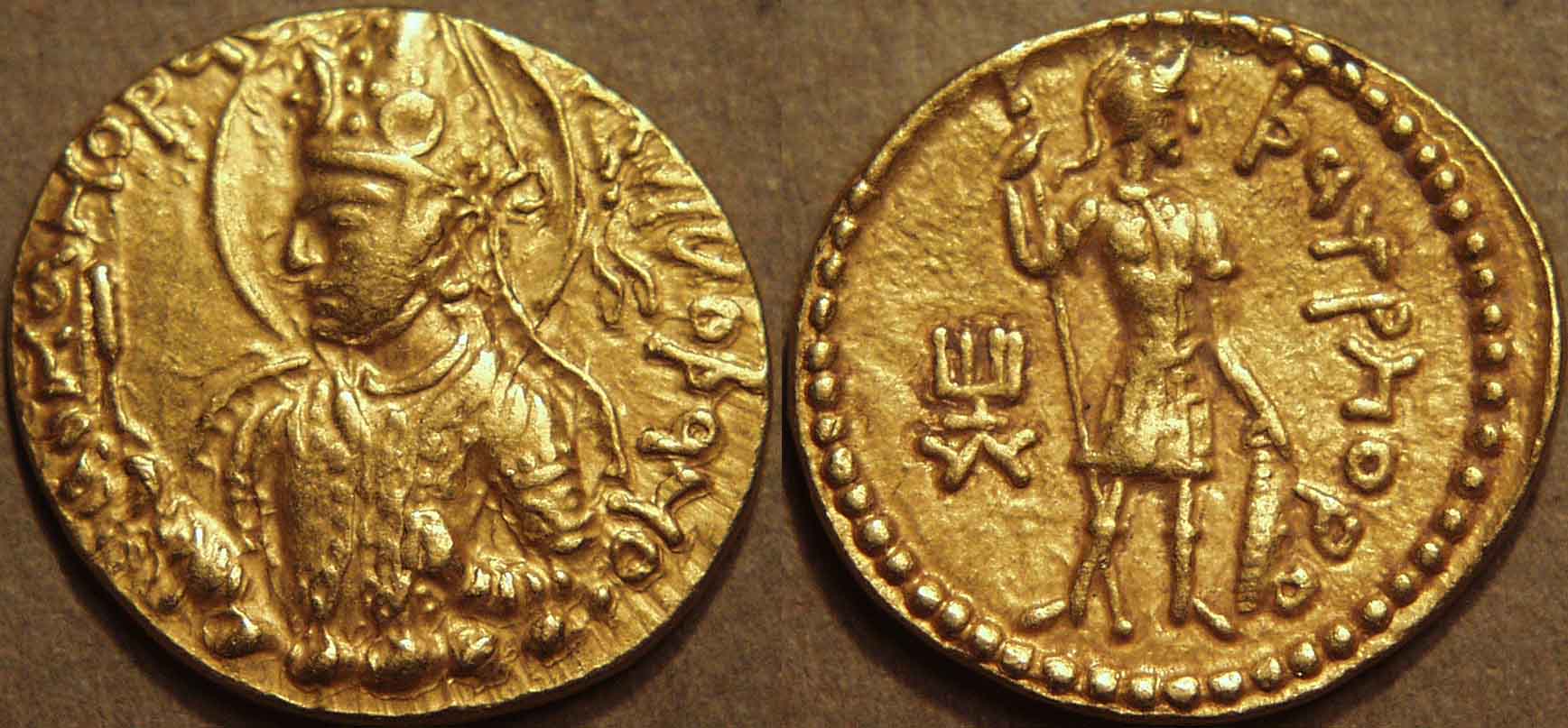 |
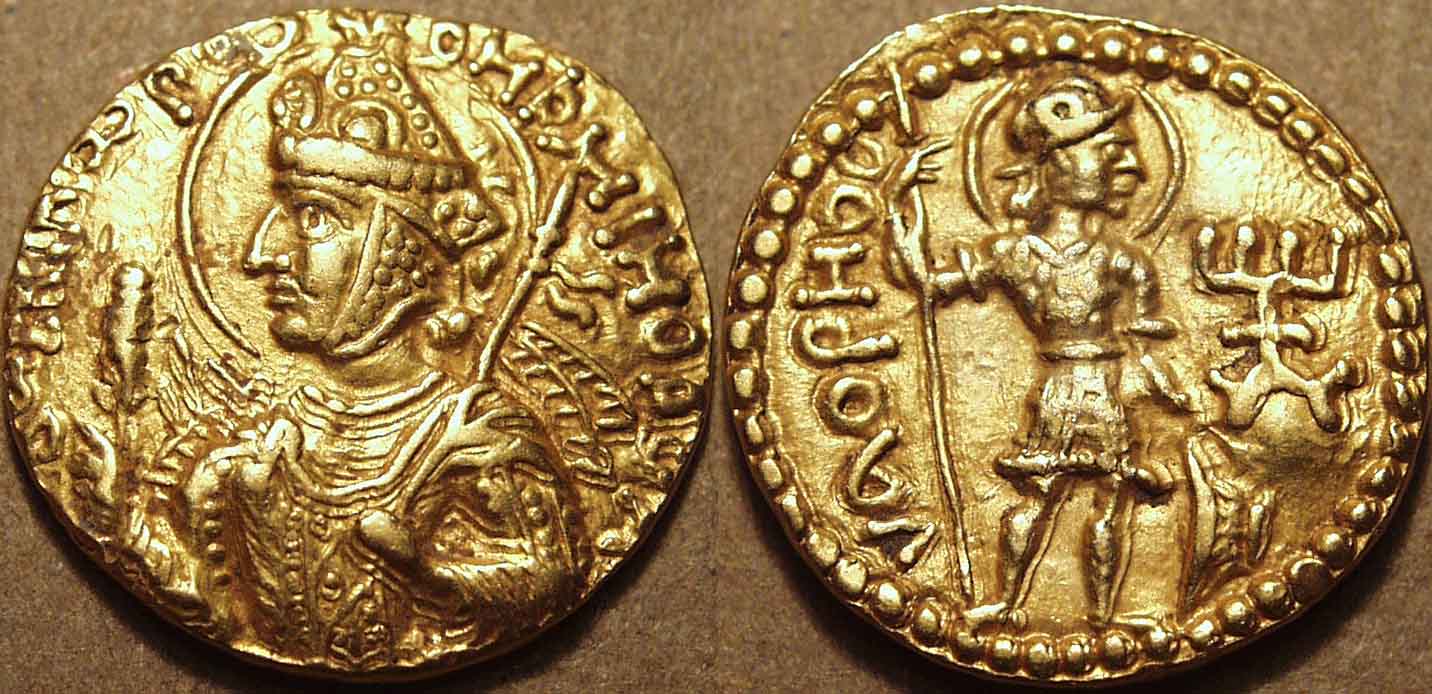 |
 |
Gold Quarter Dinars |
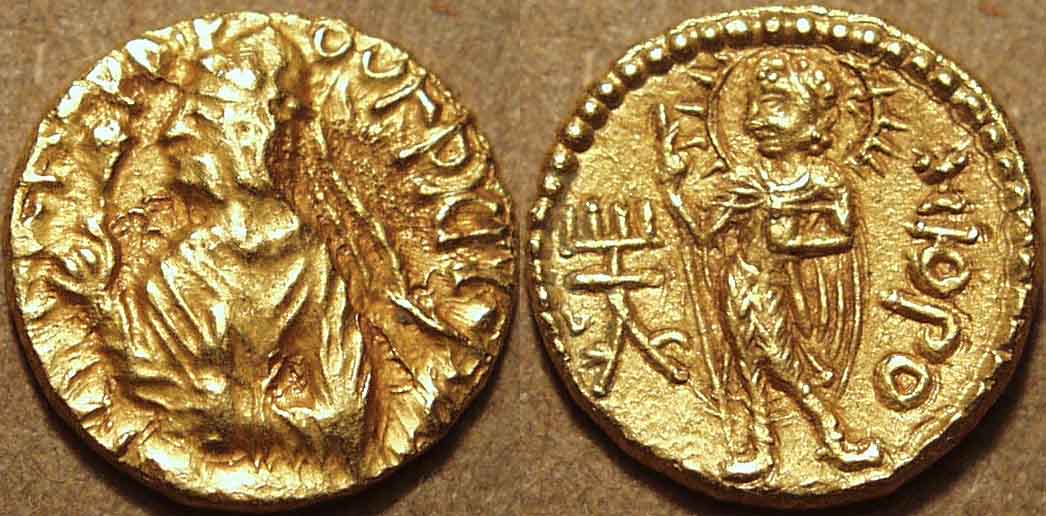
|
Gold quarter dinar, c. 155-190 CE
Weight: 1.98 gm., Diam: 13 mm., Die axis: 12 o'clock
Crowned, diademed bust of king left, holding mace and elephant goad,
Bactrian legend around: þAONANOþ ... OOηþKI KOþANO
(King of Kings Huvishka Kushan) /
Solar deity Mithra standing left, one hand on sword hilt, the other holding staff,
Bactrian legend right: MIOPO, tamgha at left
unpublished quarter denomination of Göbl 170 |
 |
Huvishka's quarter dinars are generally of poorer execution and style than the dinars. This coin is of relatively god style
and execution compared to most. Deities featured on the quarter dinars include: Ardochsho, Mao, Mithra, Nana, Pharro, Serapis and Skanda-Kumara-Bizago. |
 |
 |
 |
Bronzes |

|
AE tetradrachm or unit, c. 155-190 CE
Weight: 12.29 gm., Diam: 24-25 mm., Die axis: 1 o'clock
King riding elephant left, holding elephant goad,
Bactrian legend around: þAONANOþ OOηþKE KOþANO
(King of Kings Huvishka Kushan) /
Goddess of plenty Ardochsho standing right, holding bowl and cornucopia,
Bactrian legend at left: MAO (!), tamgha at right
Göbl 881 |
 |
This coin is doubly unusual. Almost all of Huvishka's elephant-rider coins have the elephant walking to the right, but
on this coin the elephant is walking to the left. More unusual is the mis-match between the image and the legend on the reverse. Although the image is clearly that of
Ardochsho, the legend reads MAO, the moon god. There is a reasonably large group of coins with this particular mis-match. An error must have been
made at some point and it got perpetuated as successive dies were cut as copies of the first, erroneous one.
Huvishka issued bronze coins in only one denomination, but the coins seem to get progressively lighter throughout his reign. The bronze coins feature three major obverse
types (with additional minor variations) and several different reverse deities, although the number of deities on the gold coins is much larger. The three major obverse types are
the elephant-rider type, couch-recliner type, and the cross-legged type. All the deities represented are present in the table below. (Thanks to Ed Snible for contributing
the photo of the cross-legged/Nana coin.)
|
\Obverse
Reverse\ |
Elephant-rider type |
Couch-recliner type |
Cross-legged type |
Ardochsho
Goddess of plenty |
 |
None known |
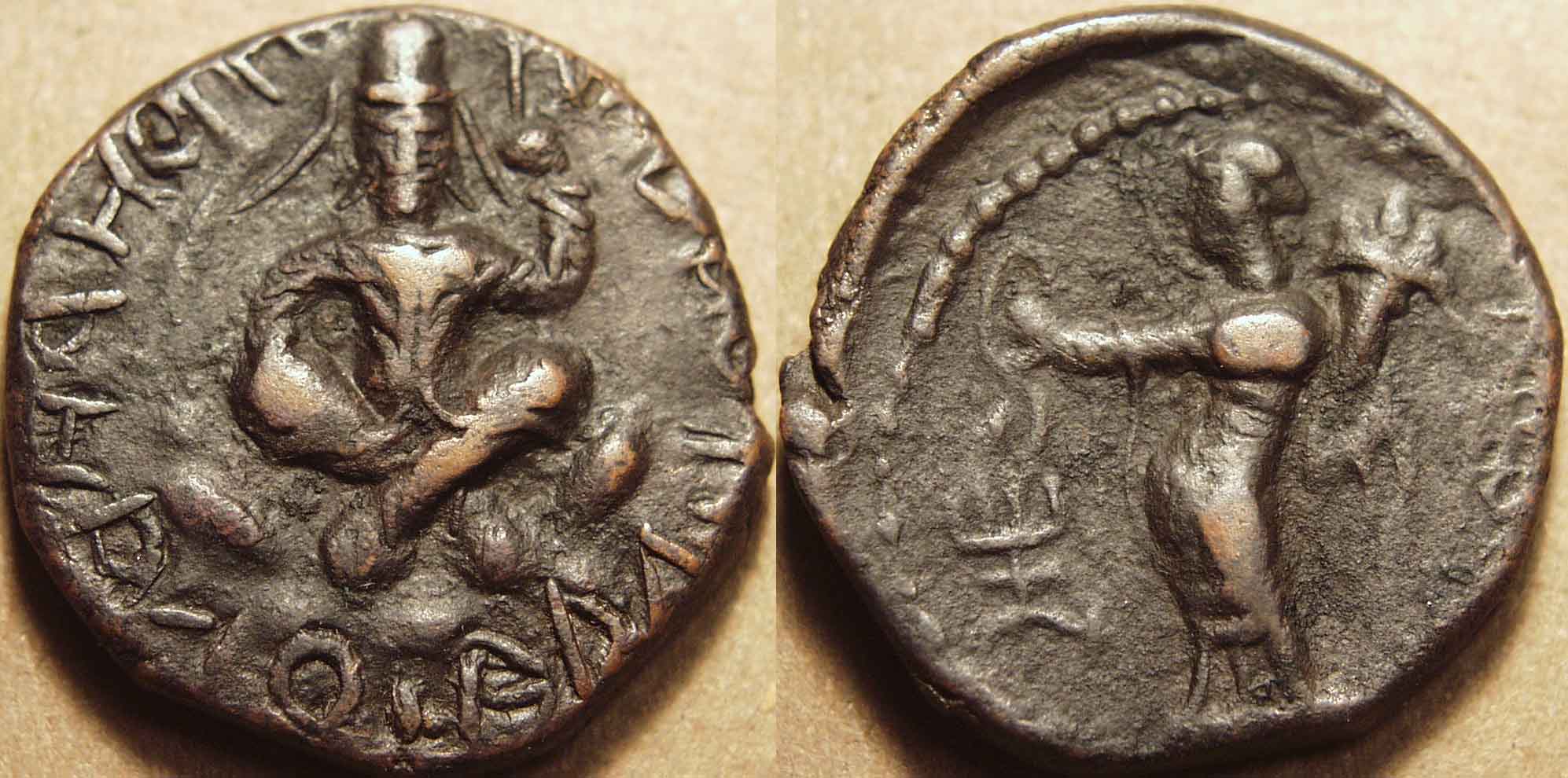 |
Athsho
God of metals & fire |
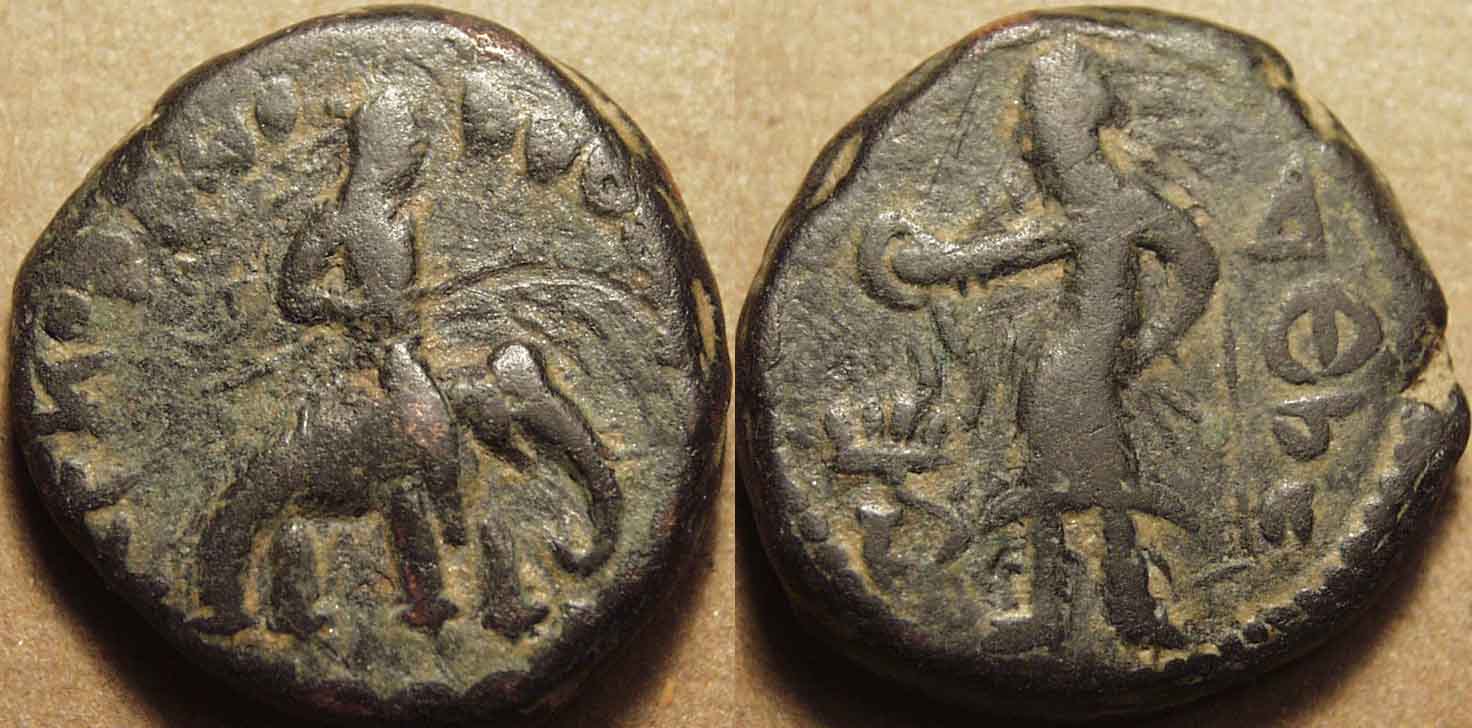 |
 |
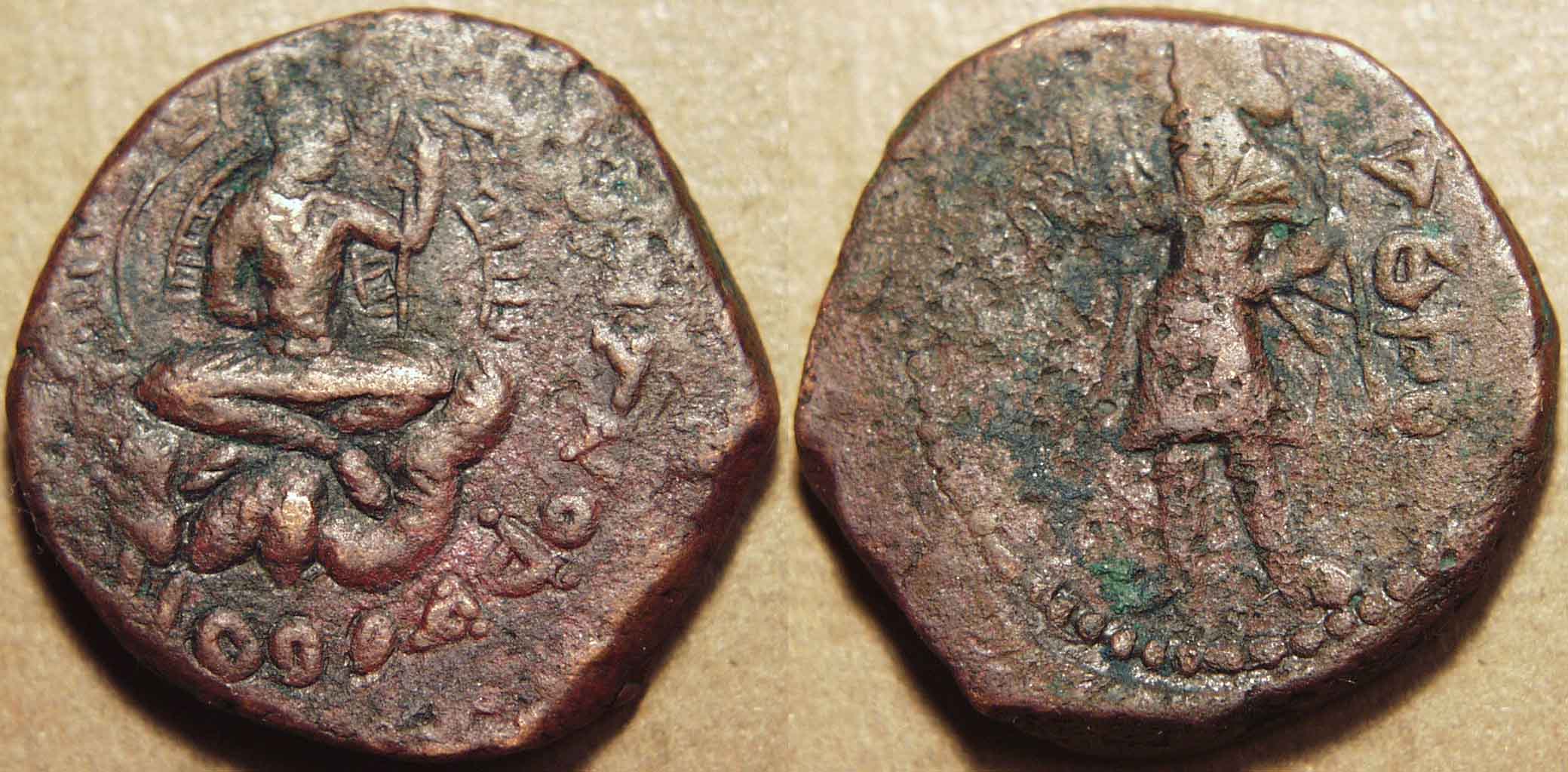 |
| Herakles |
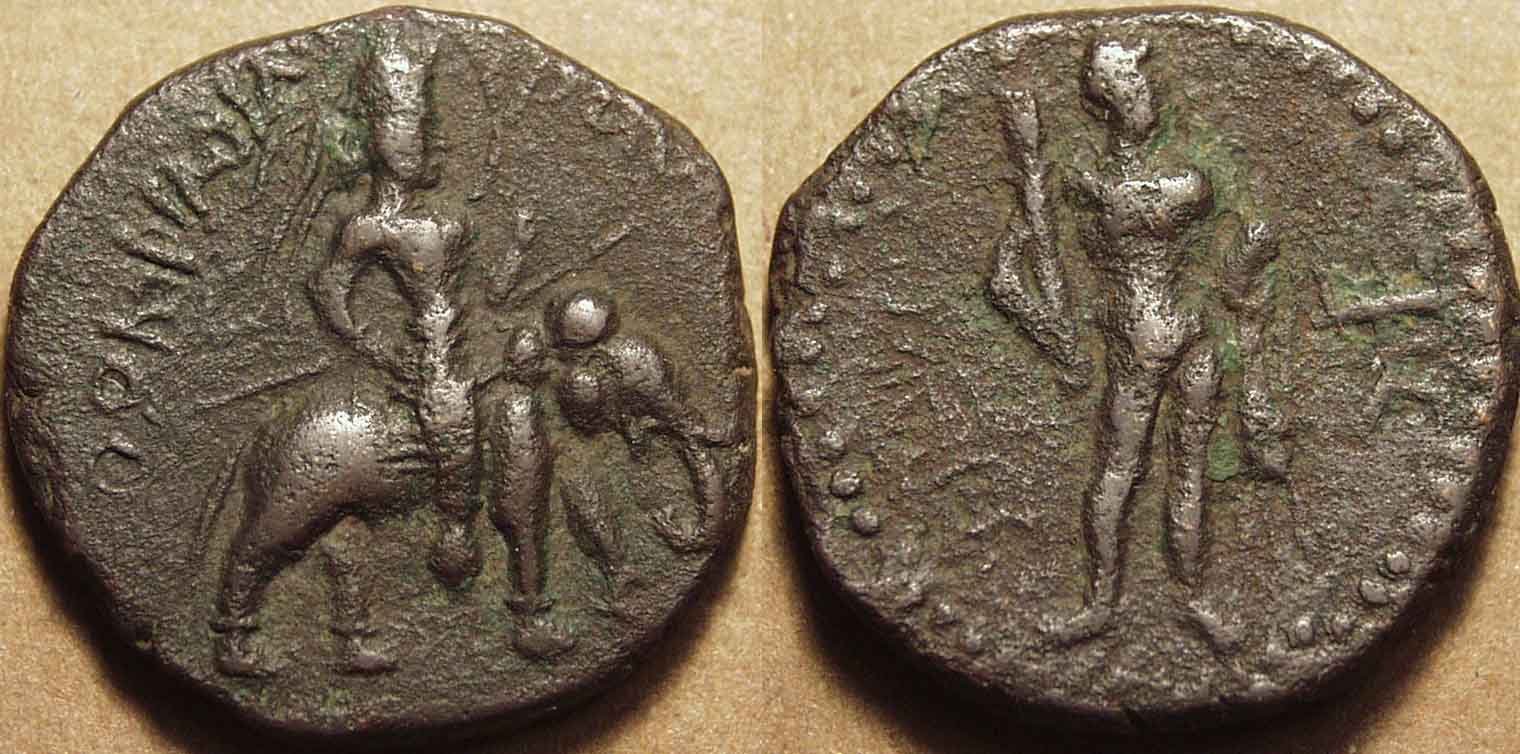 |
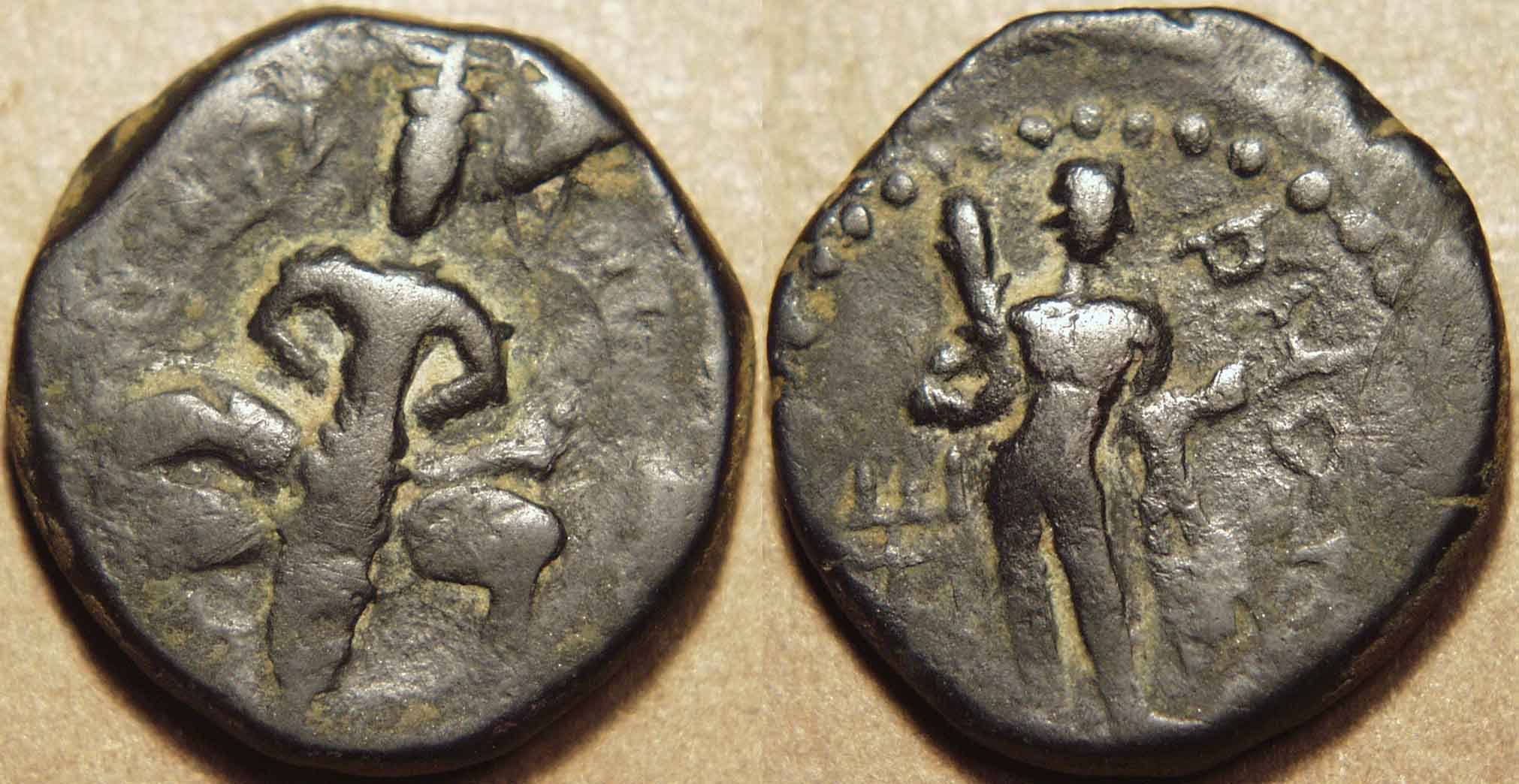 |
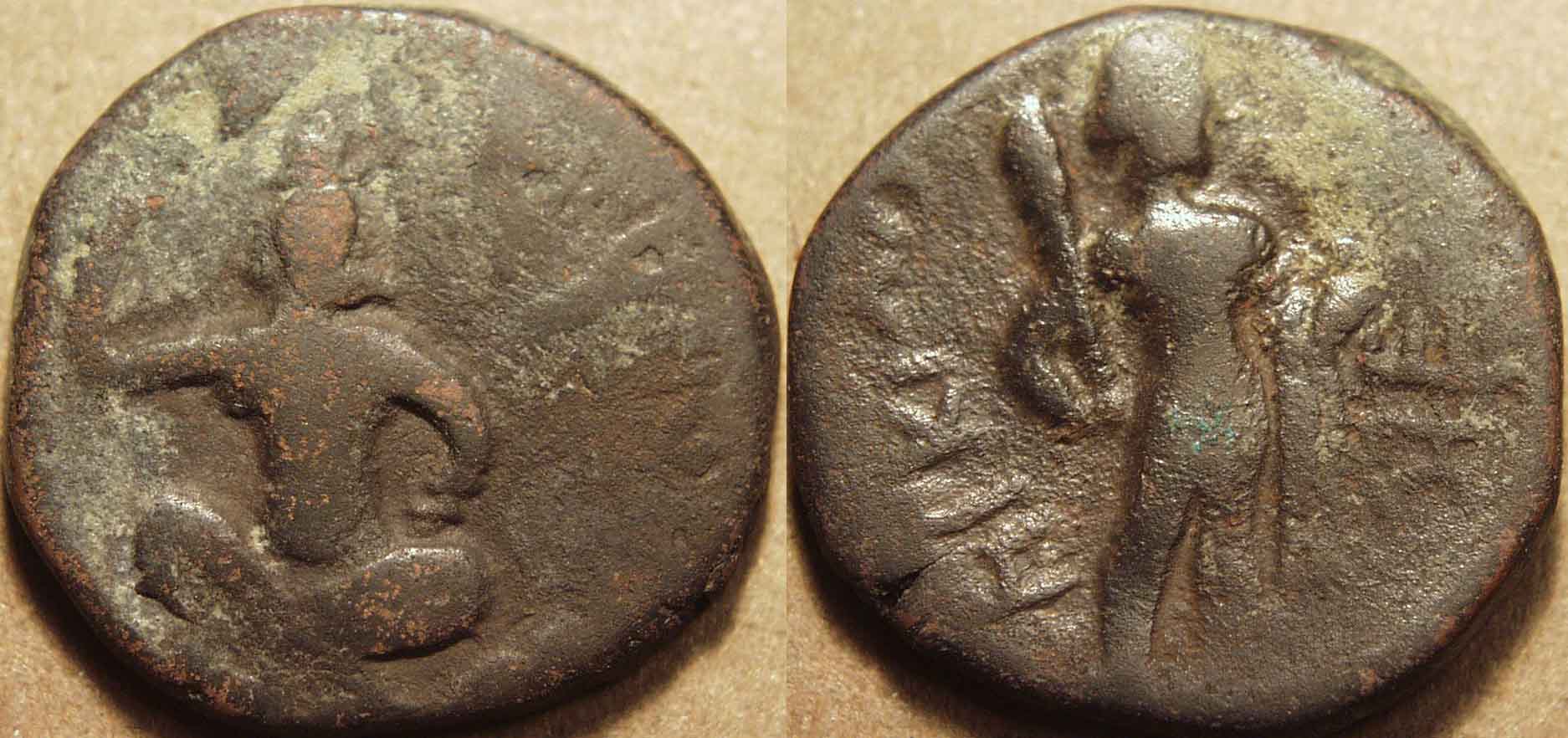 |
Mao
Lunar deity |
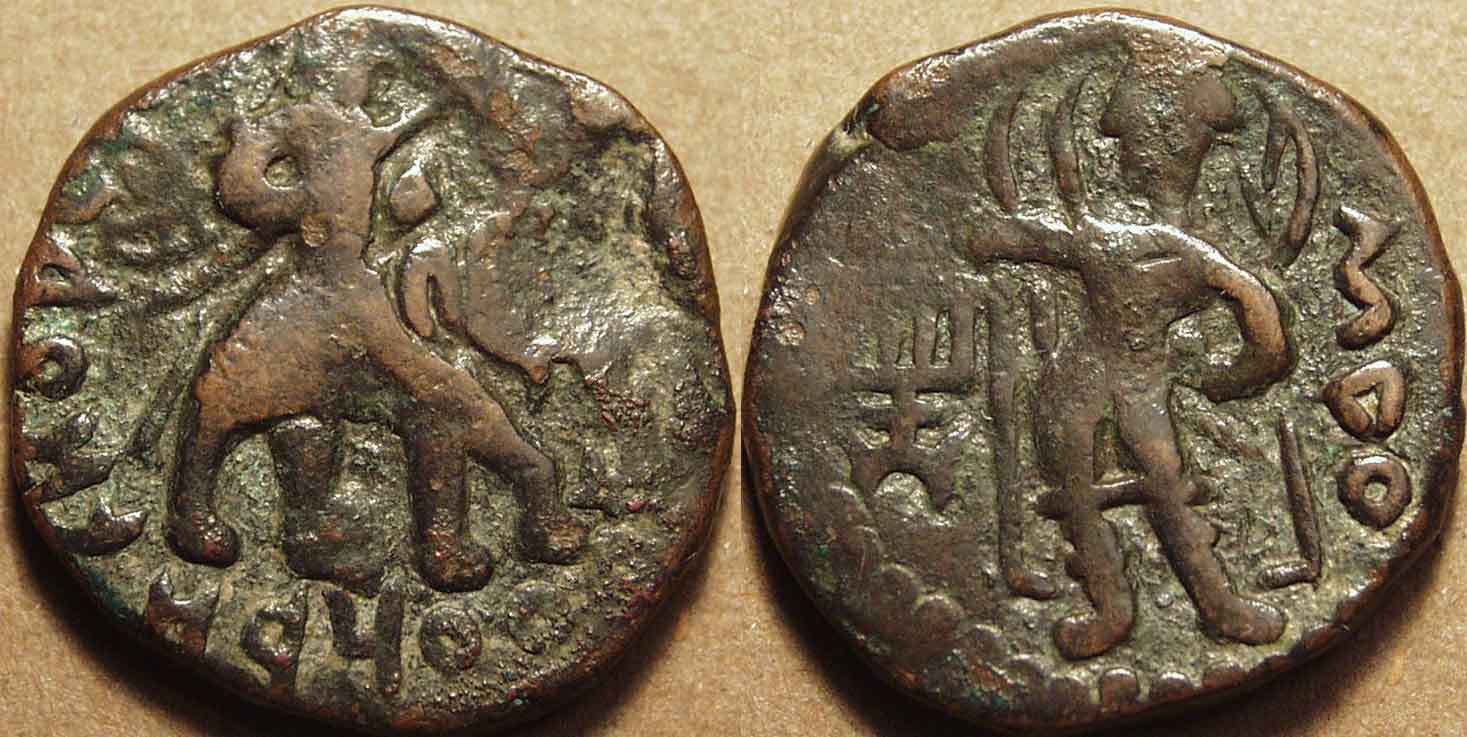 |
 |
 |
Mithra
Solar deity |
 |
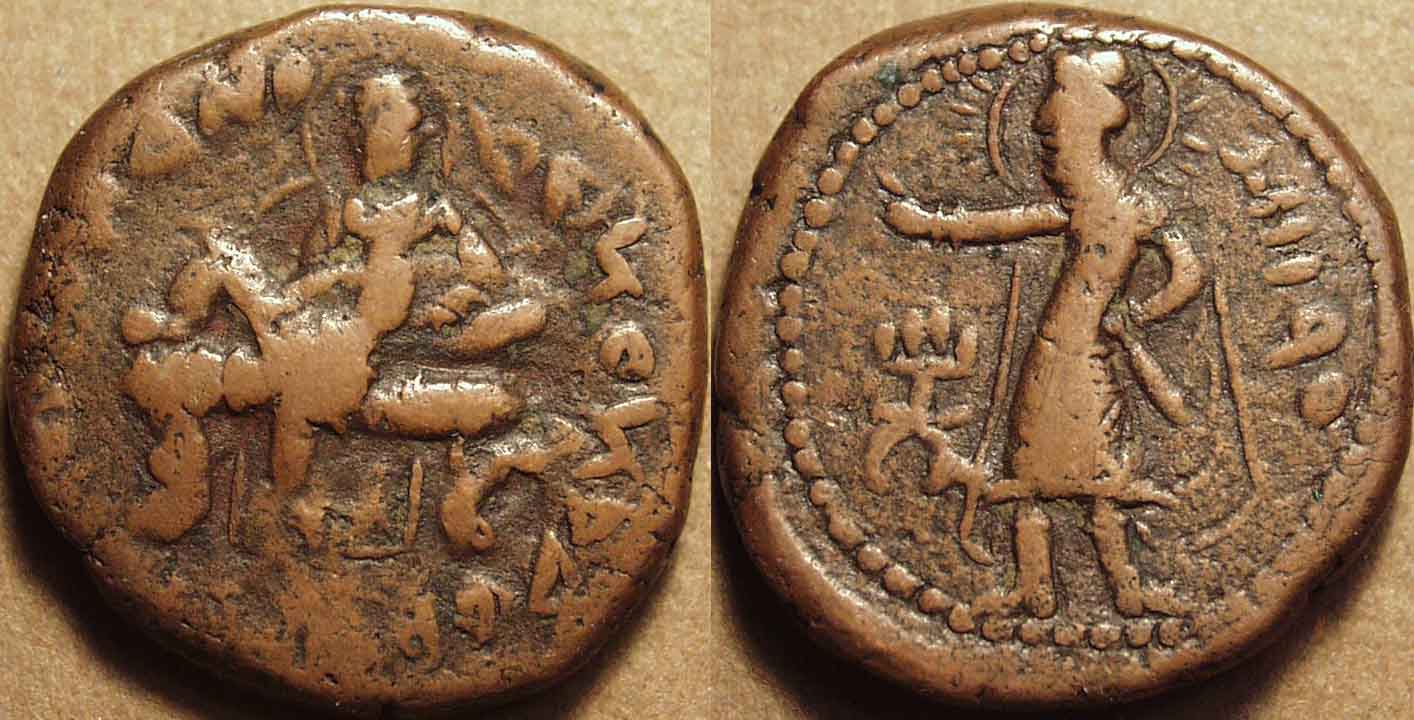 |
 |
Nana
Nature goddess |
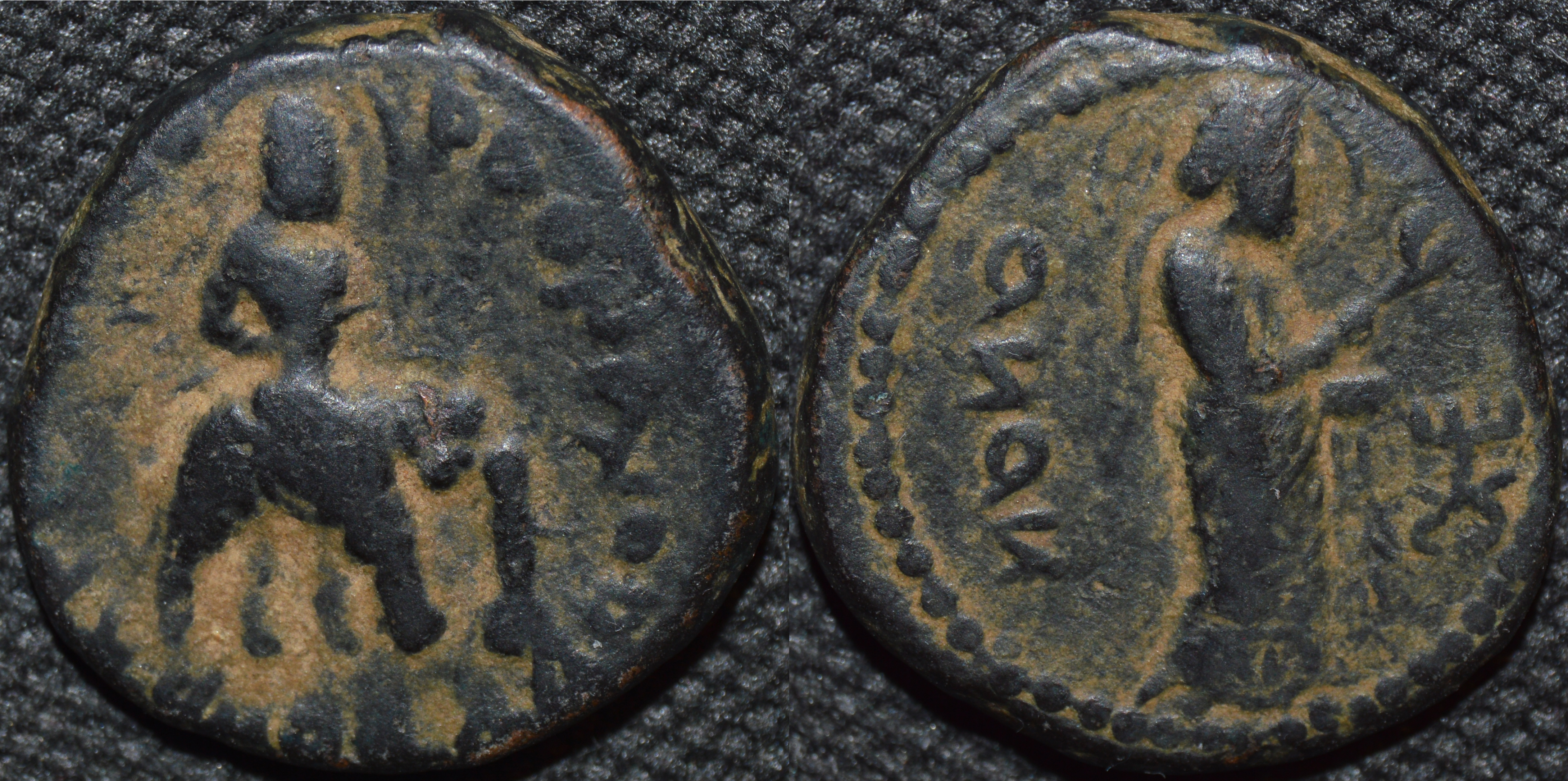 |
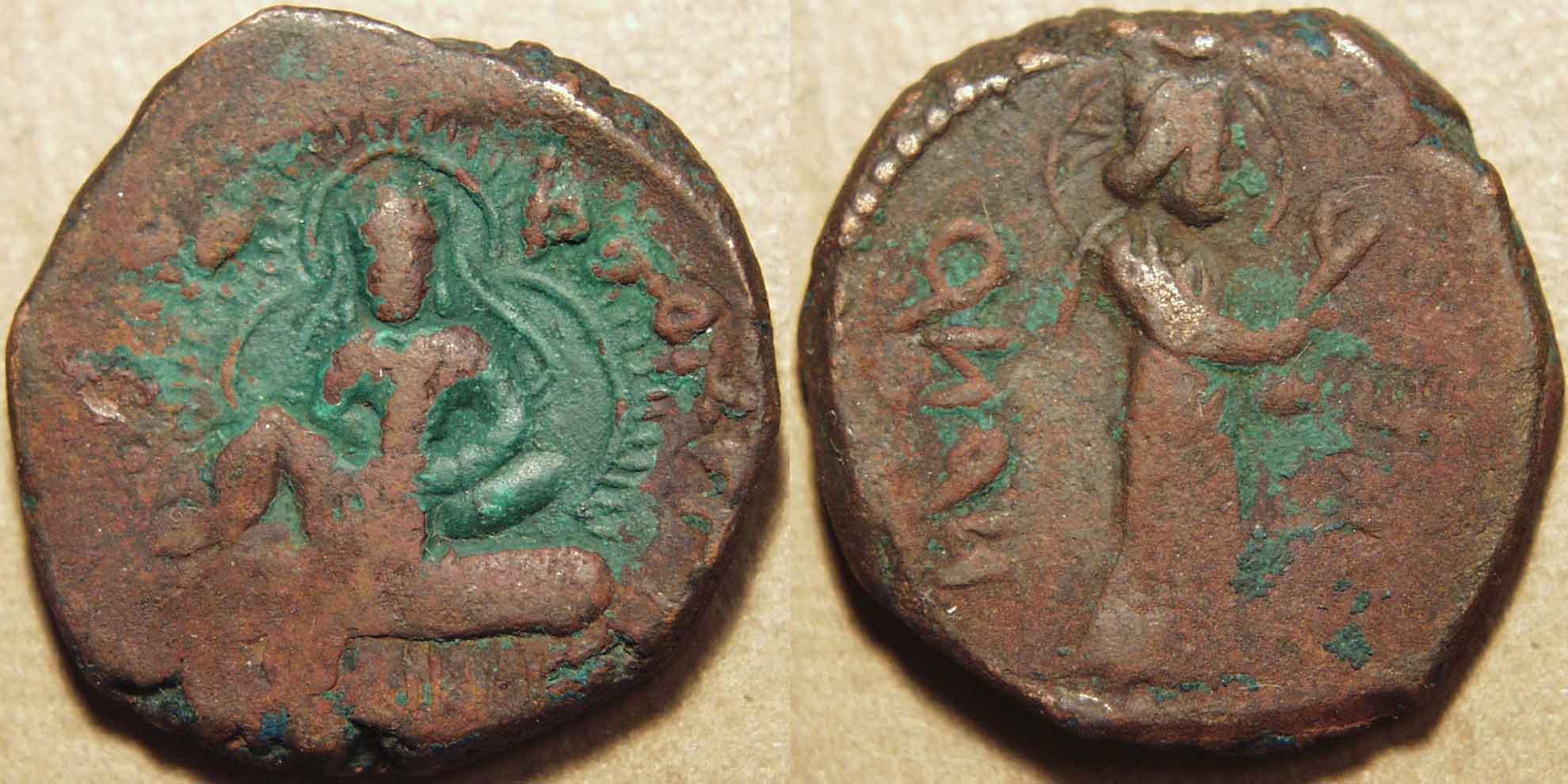 |
 |
Oado
God of the wind |
 |
 |
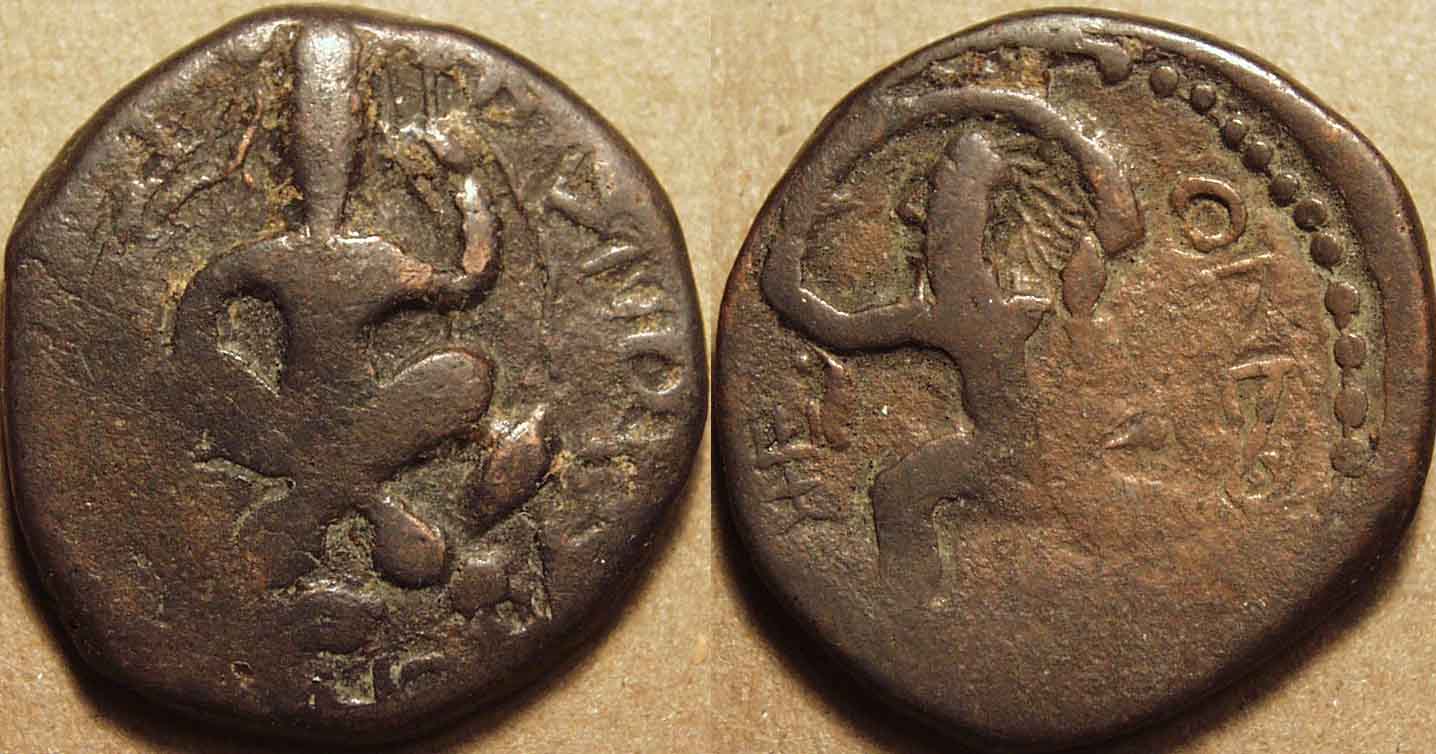 |
Oesho
(Shiva?) |
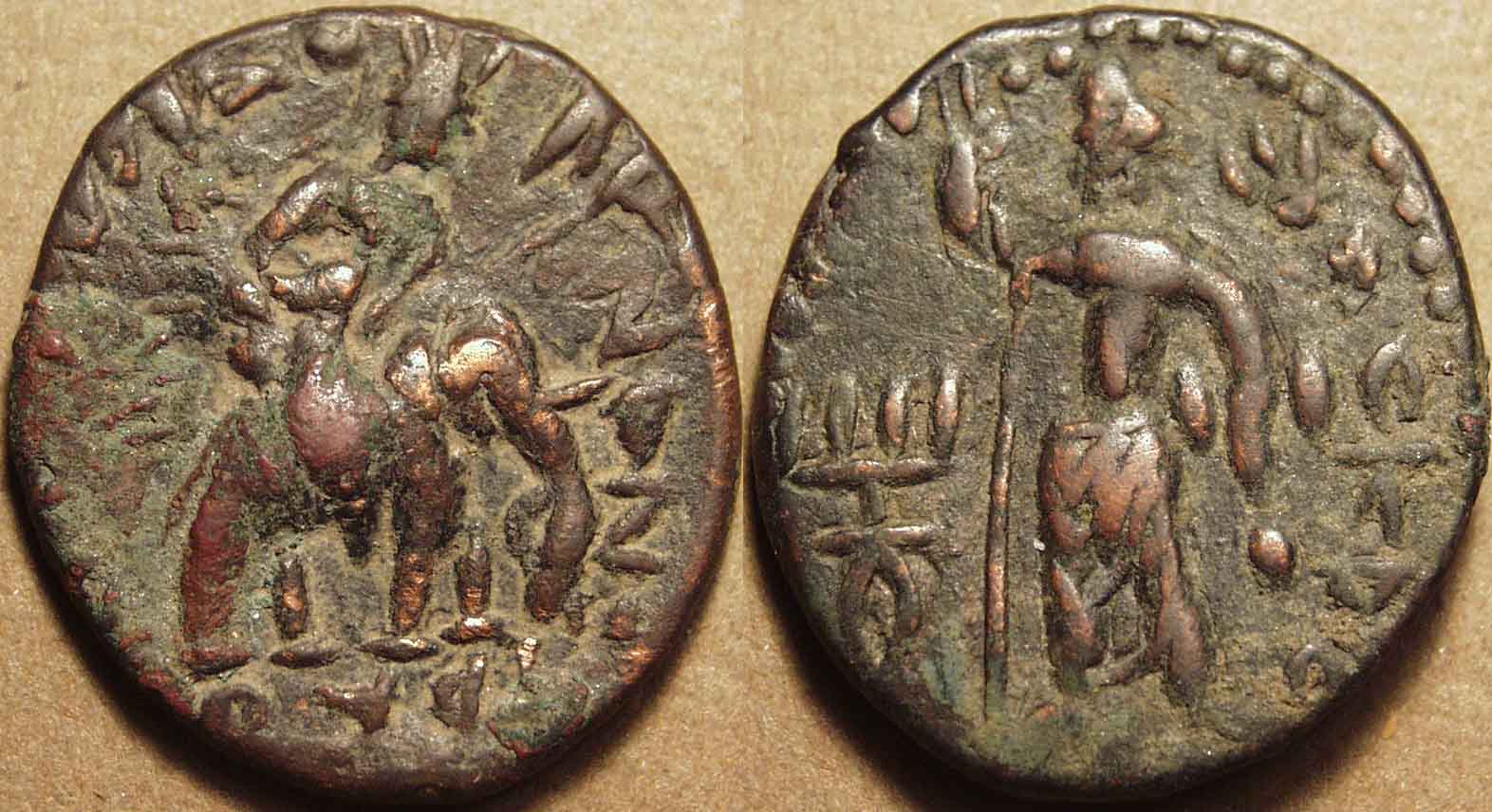 |
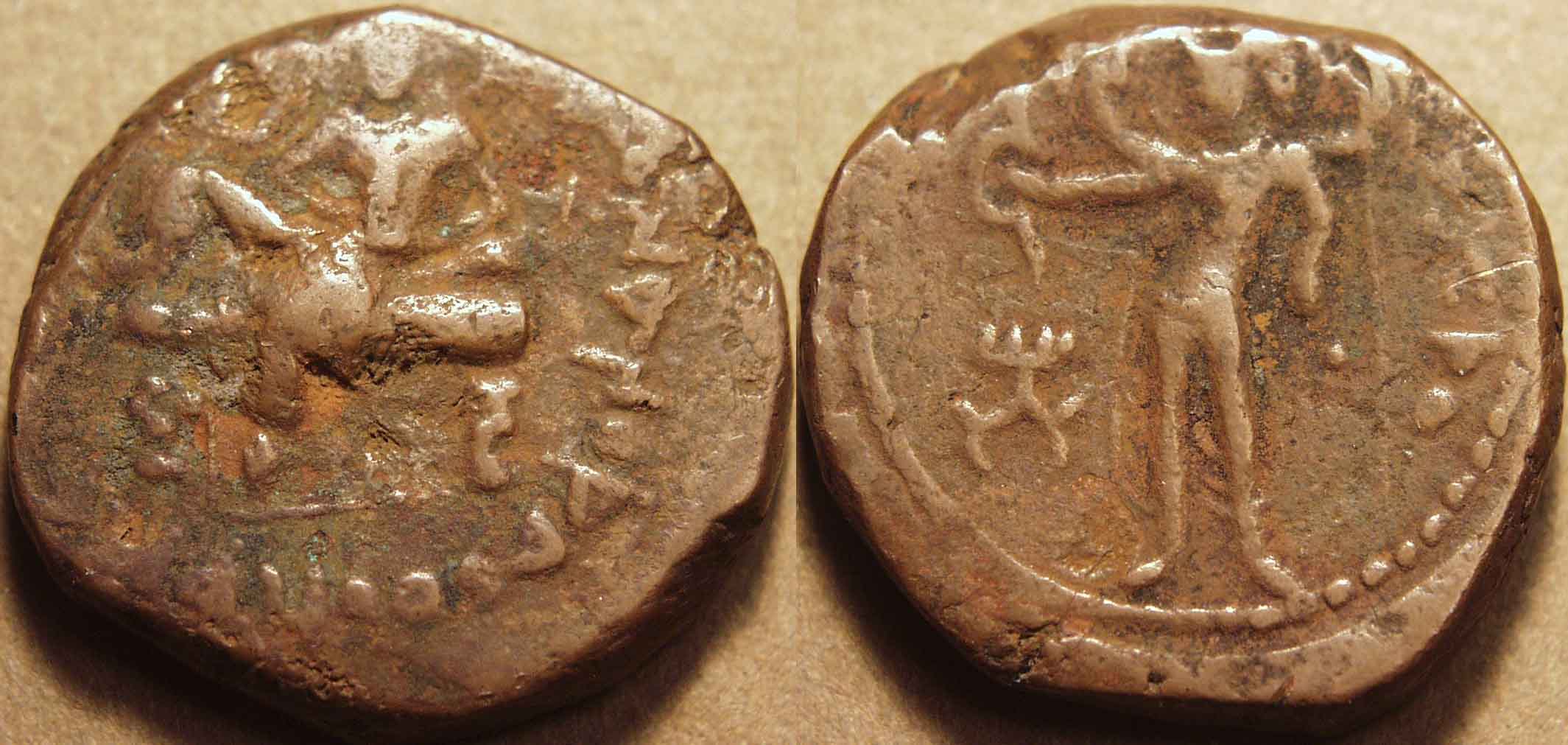 |
 |
Pharro
God who bestows royal glory |
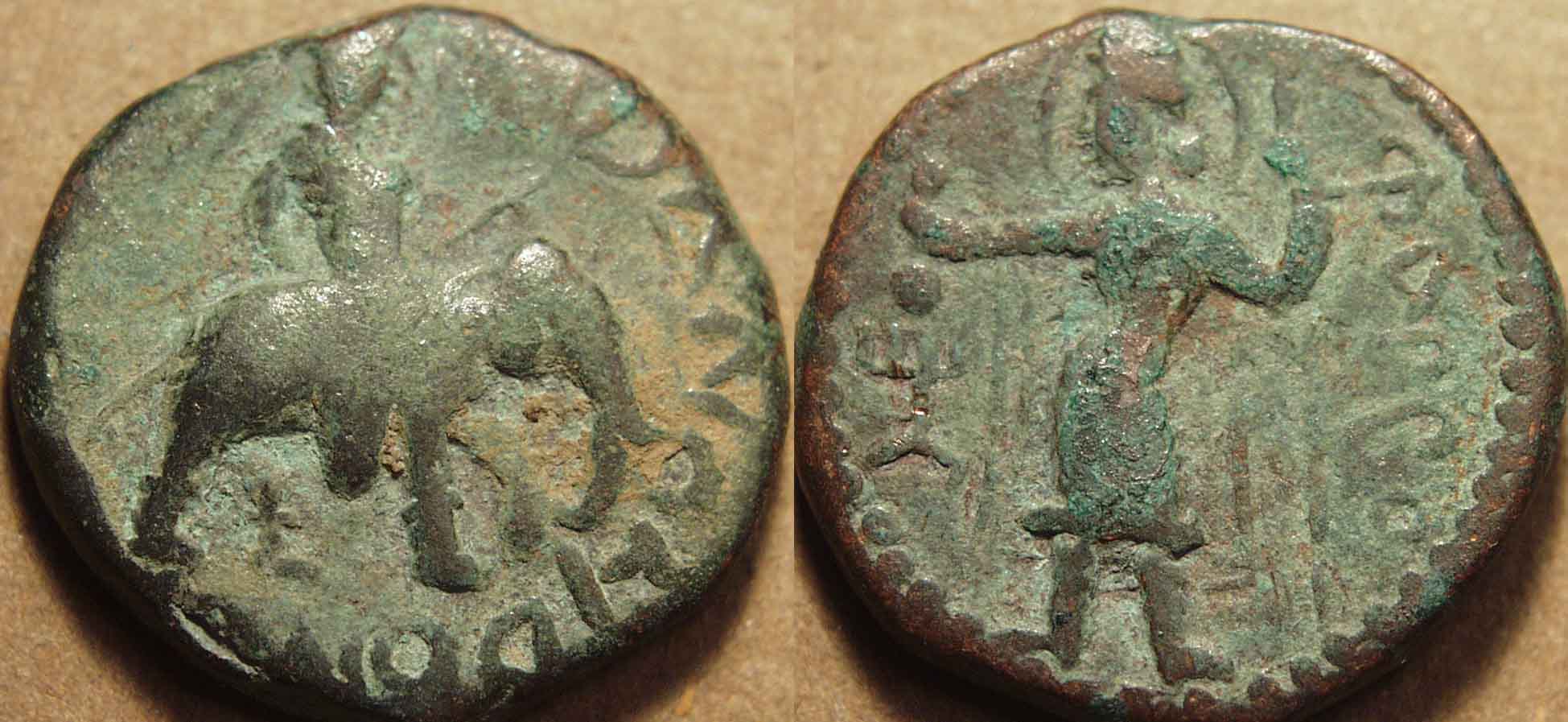 |
None known |
 |
|
|